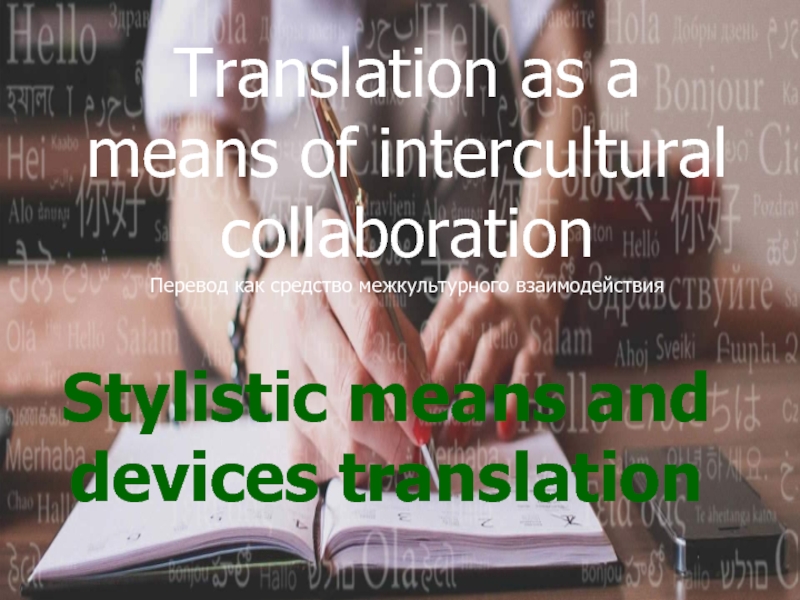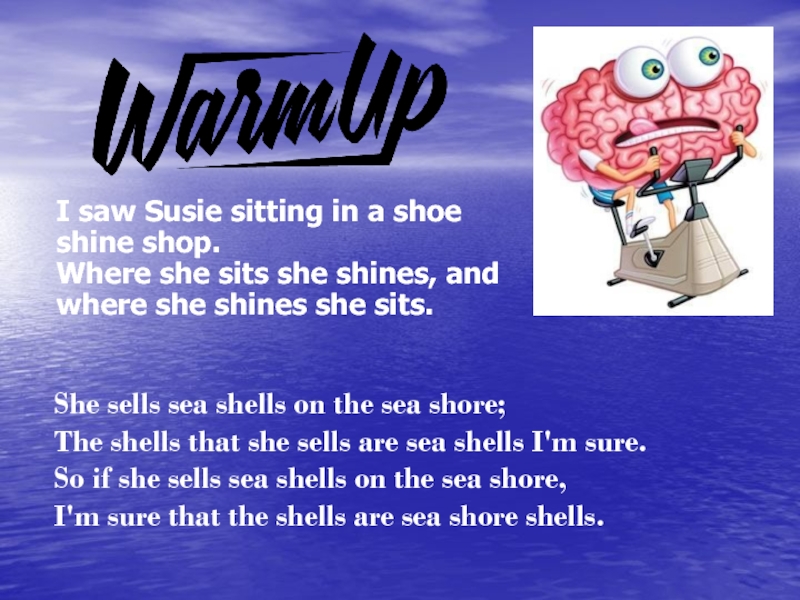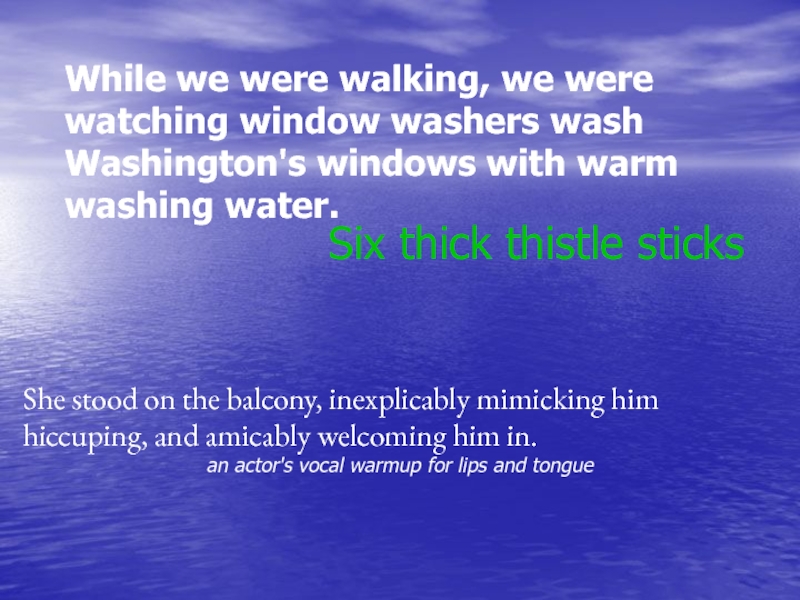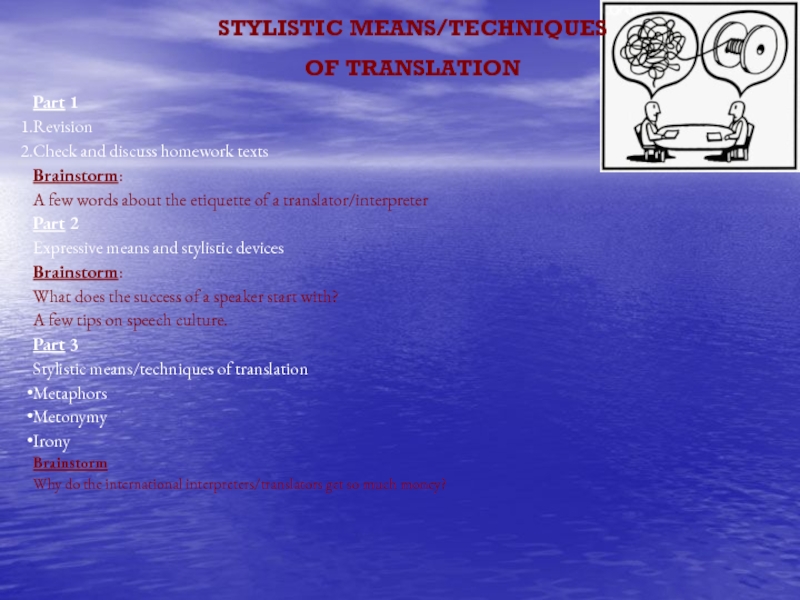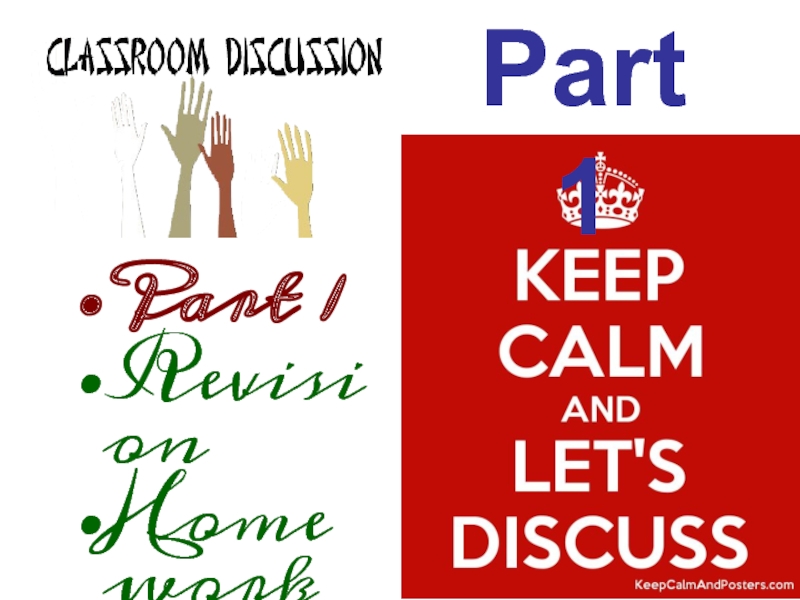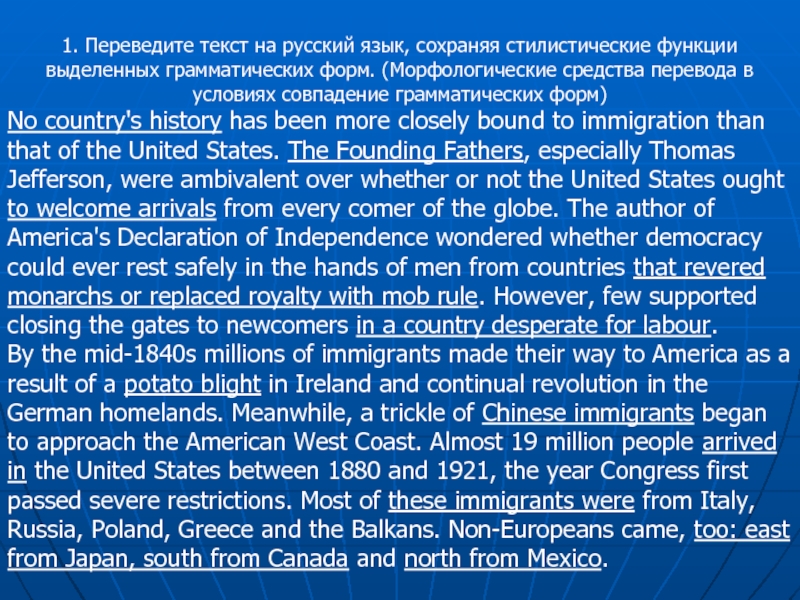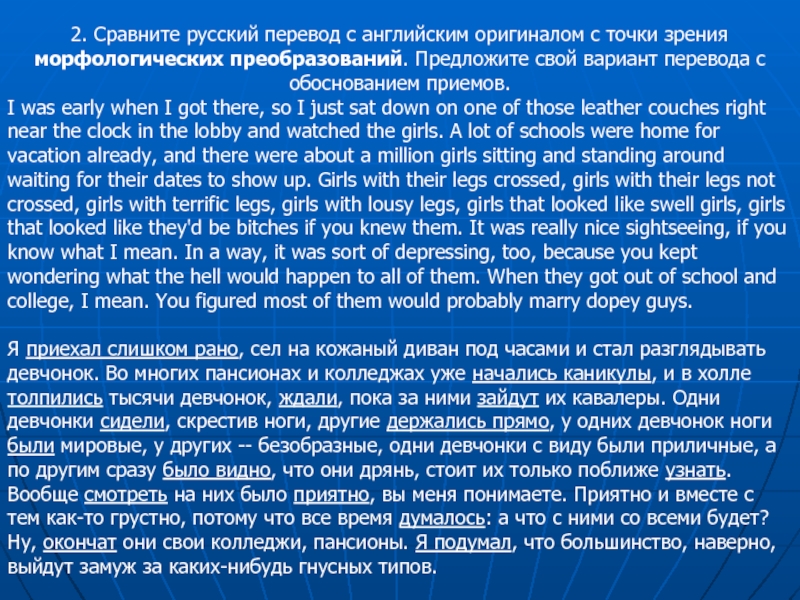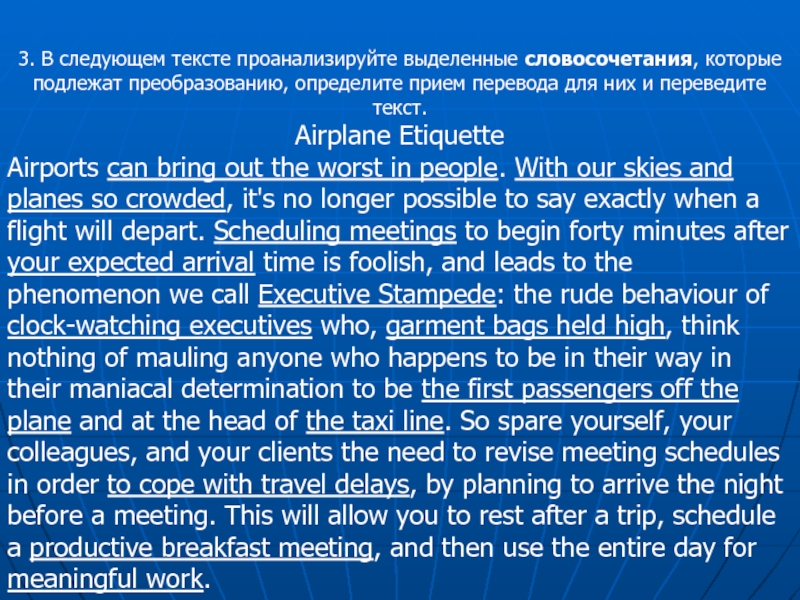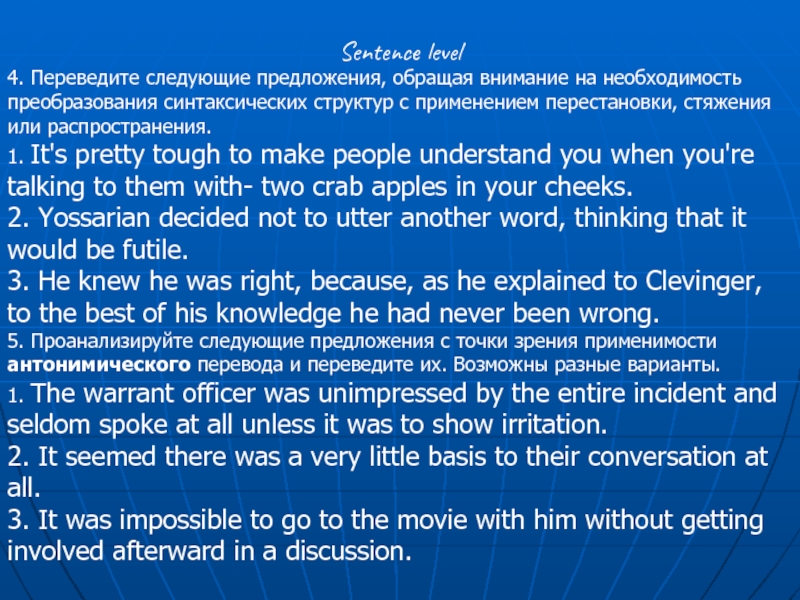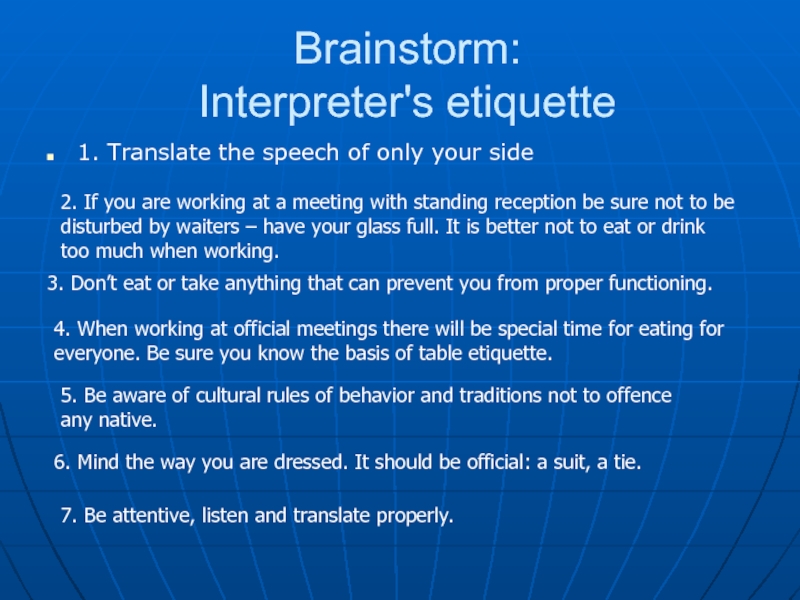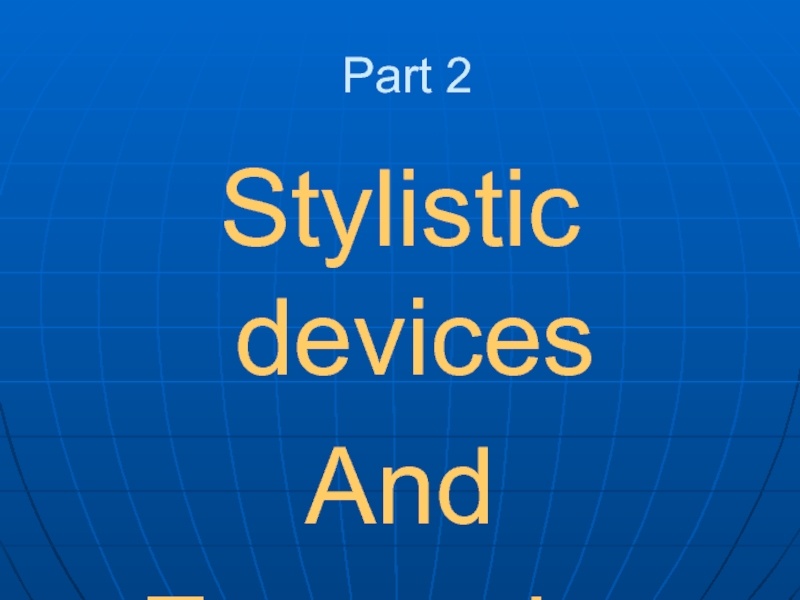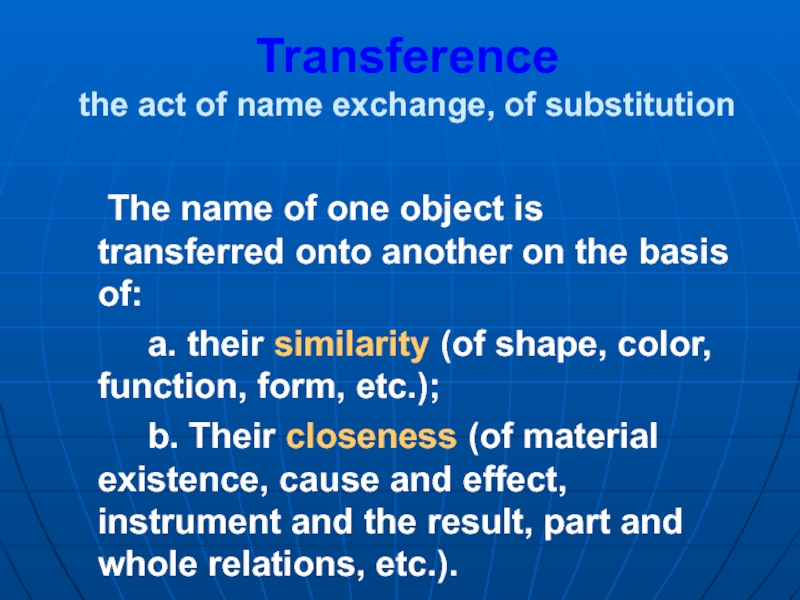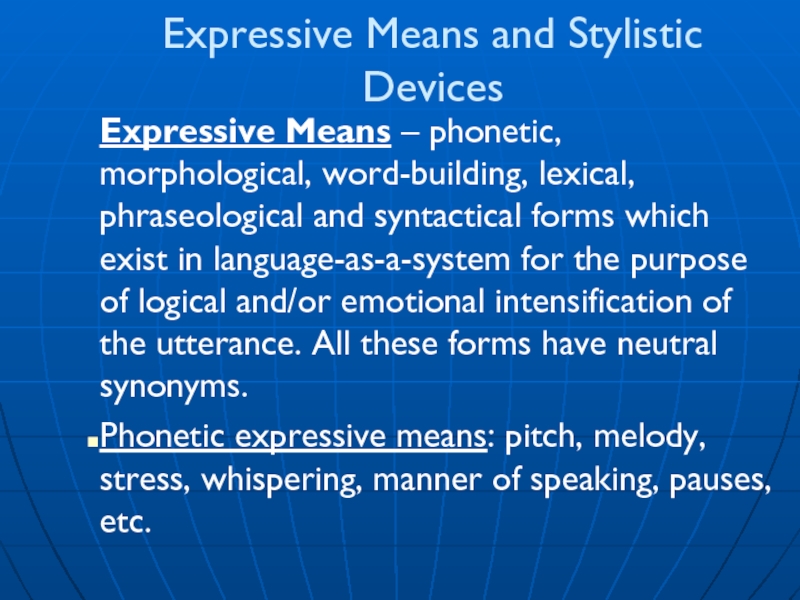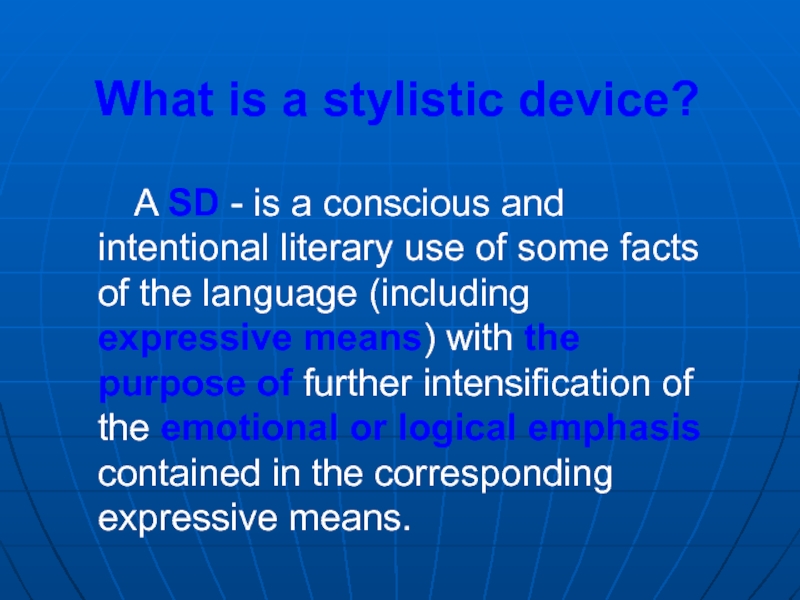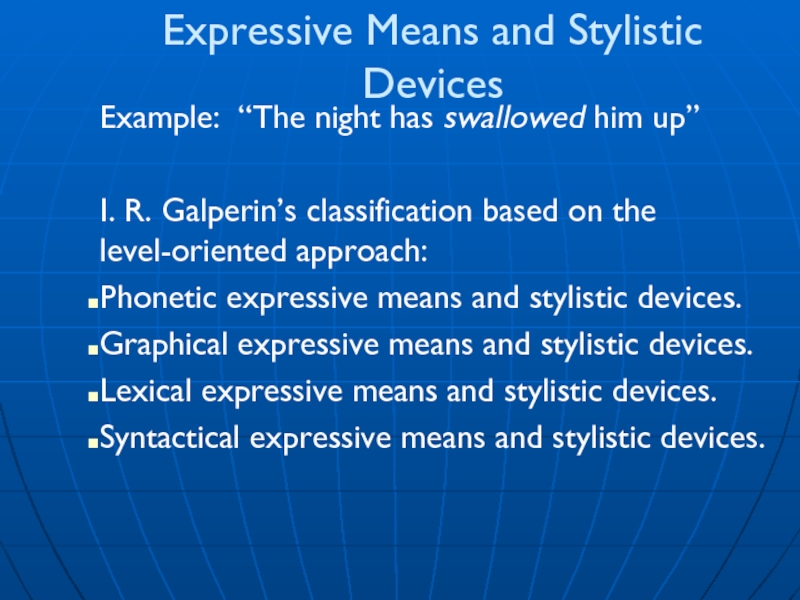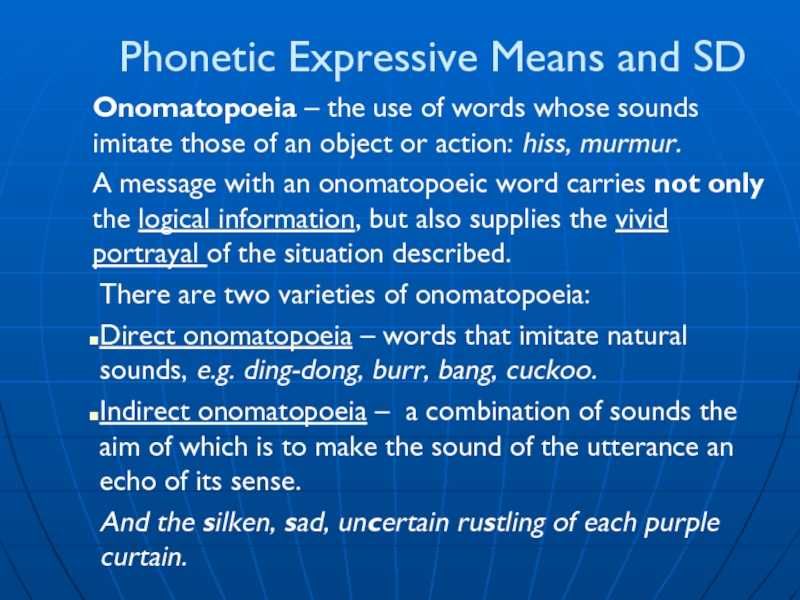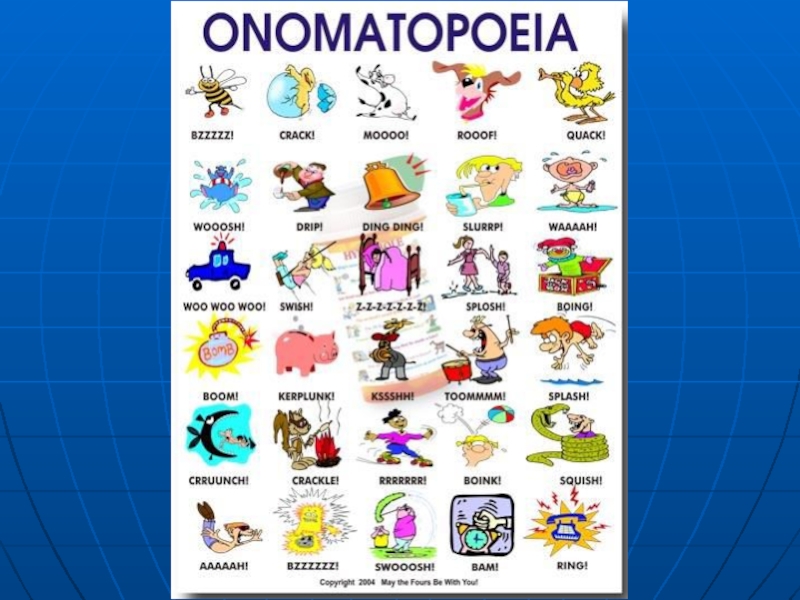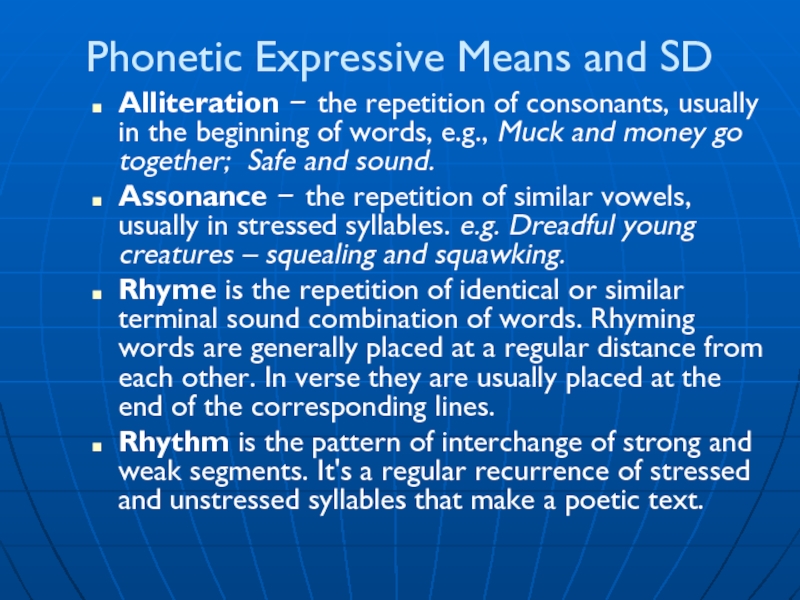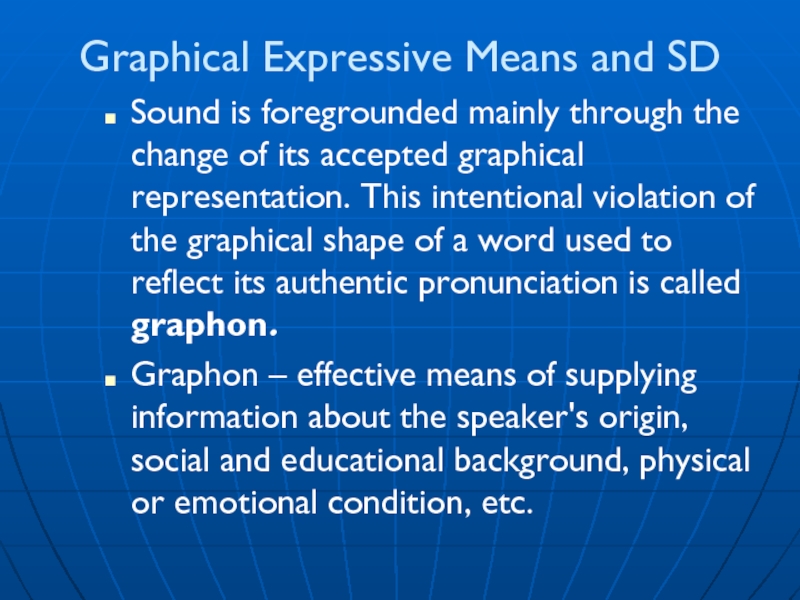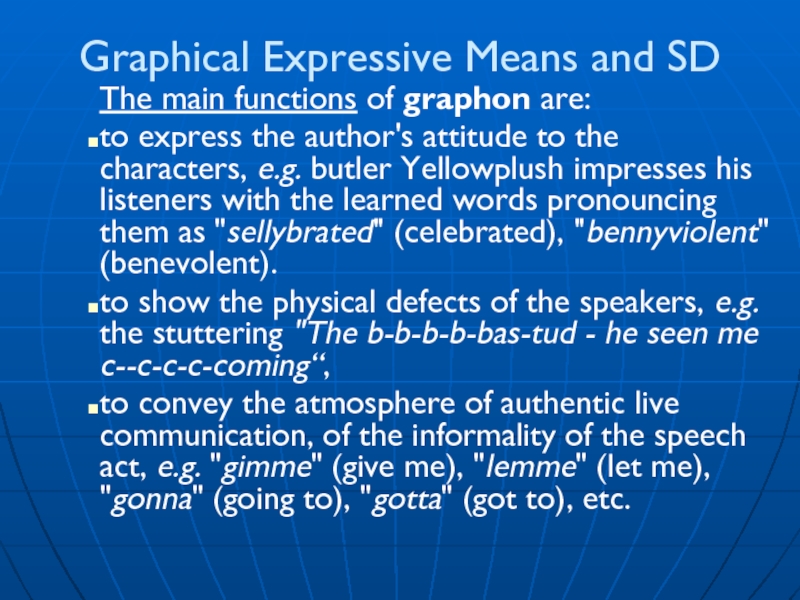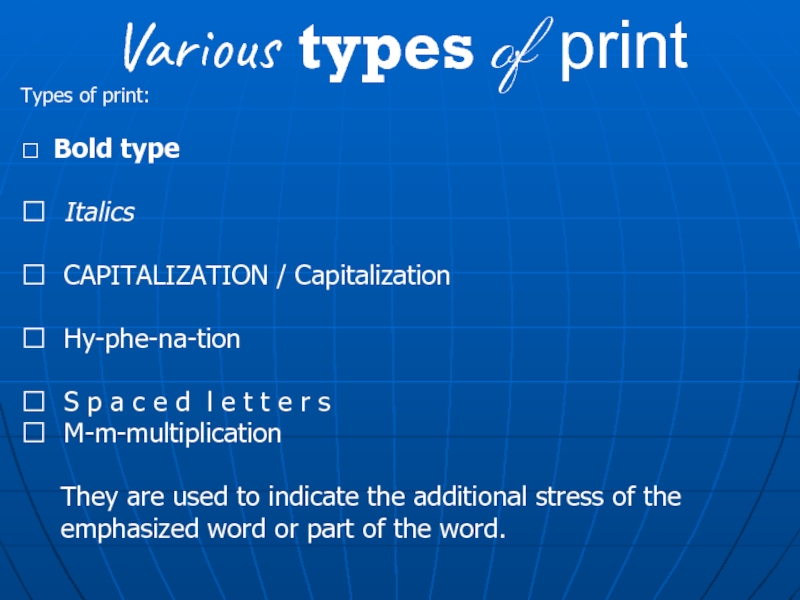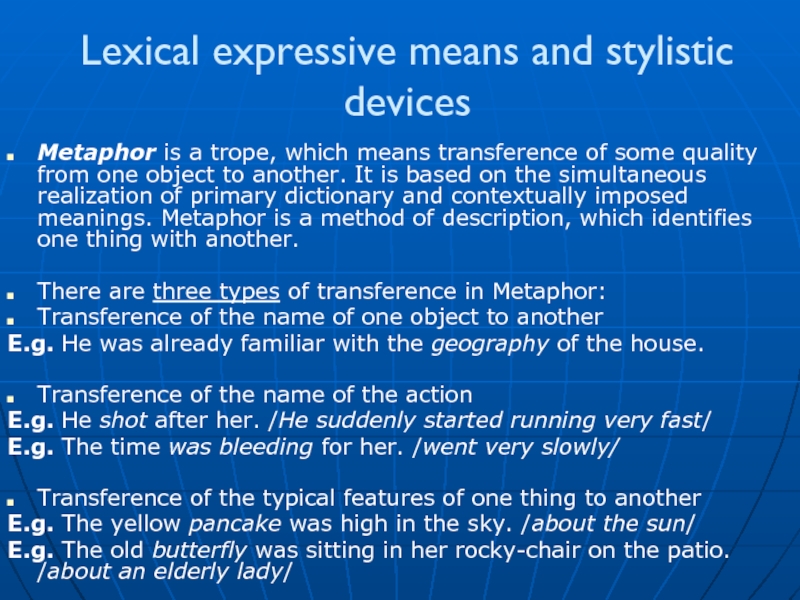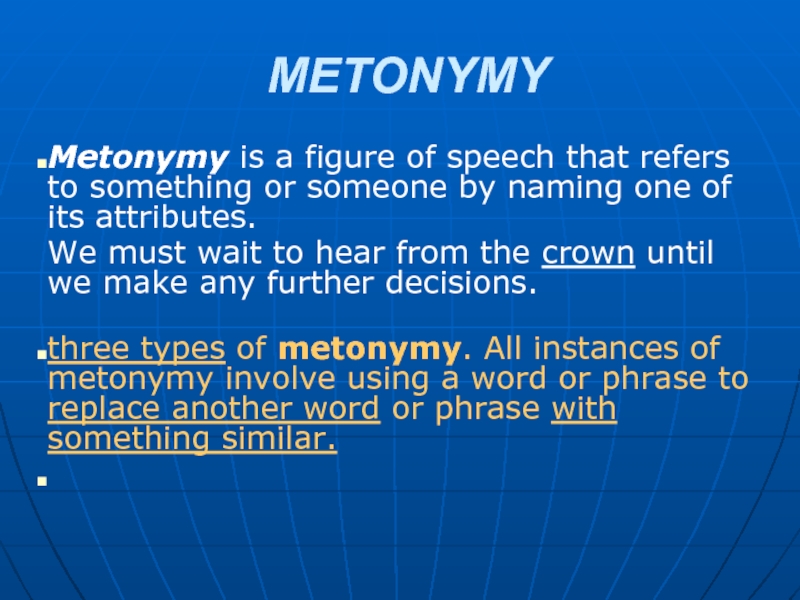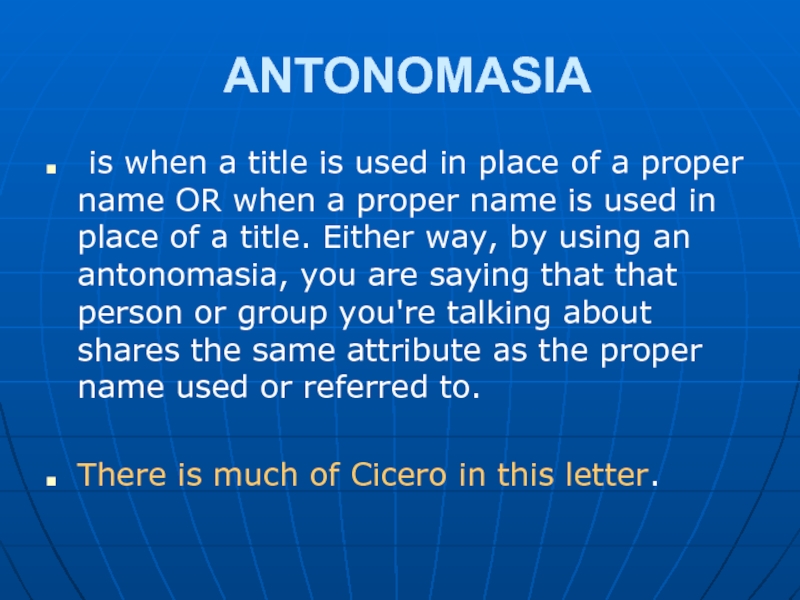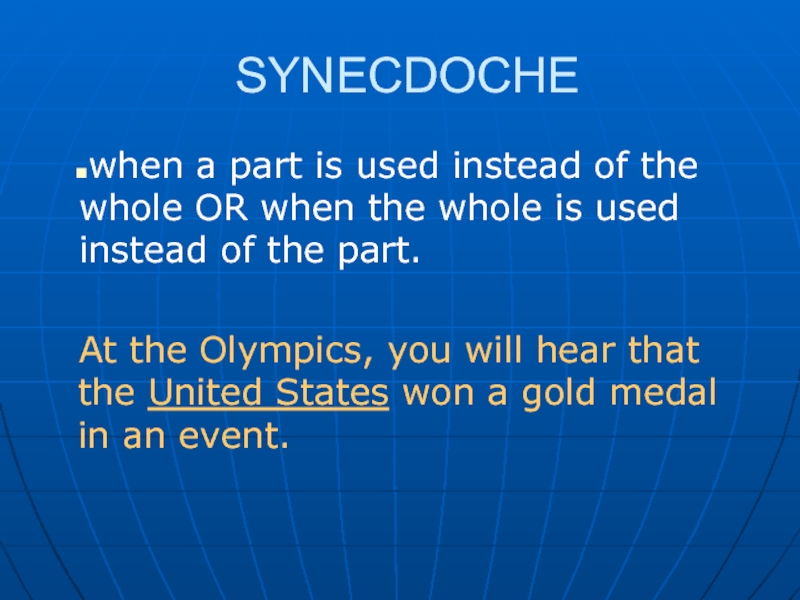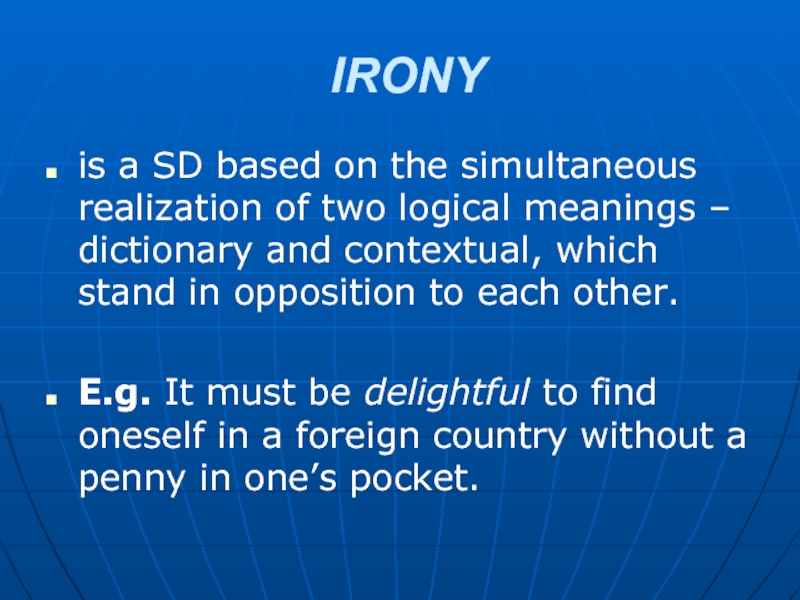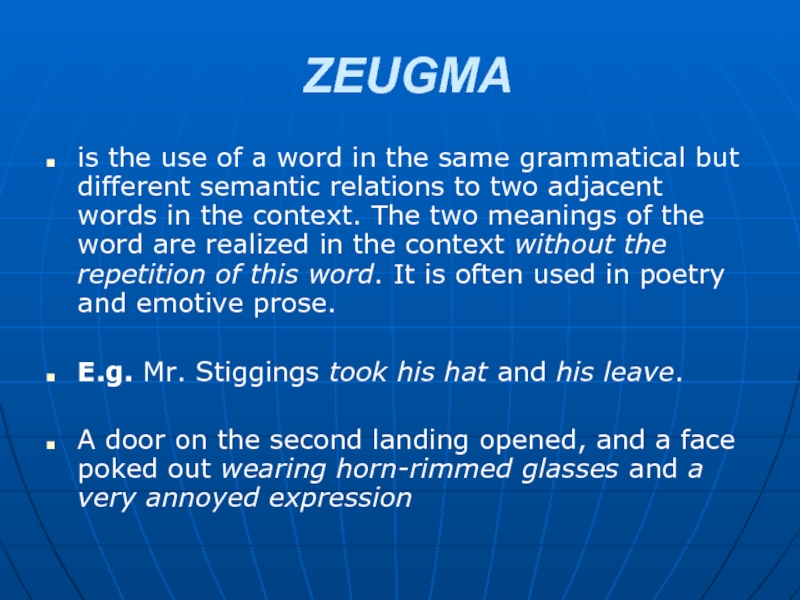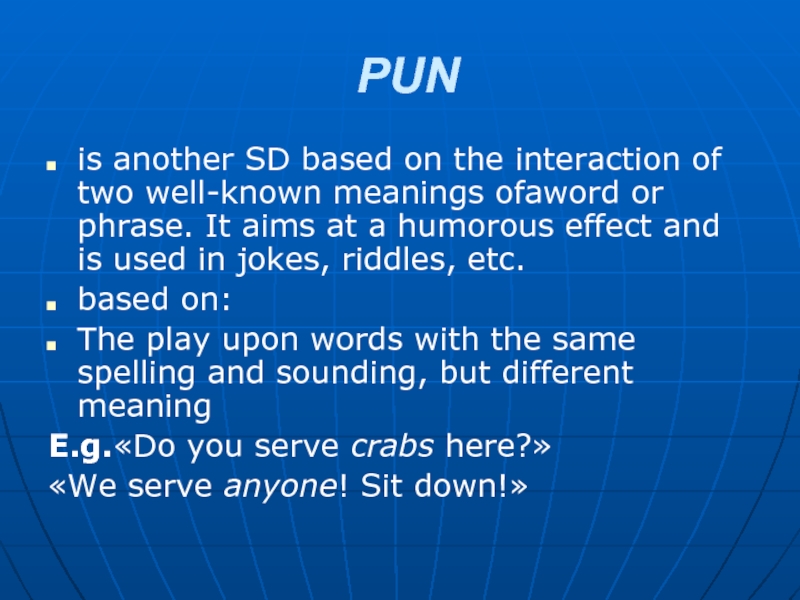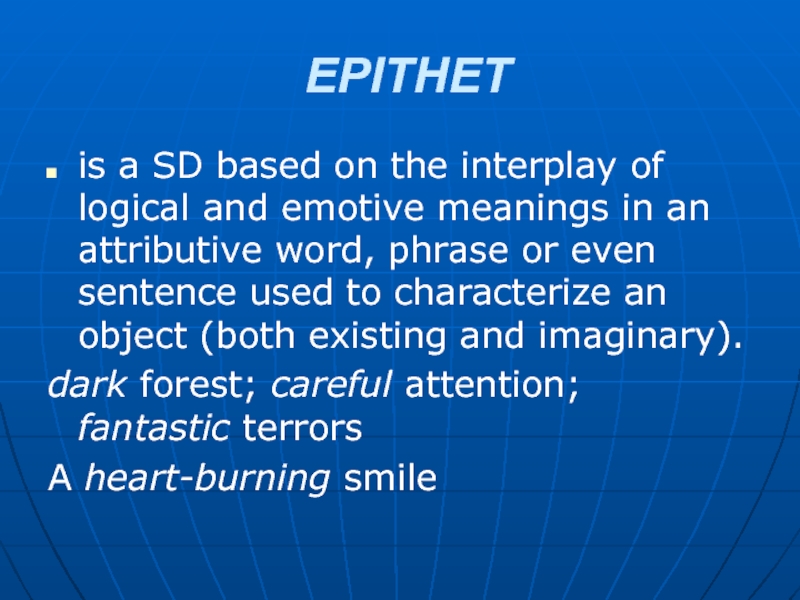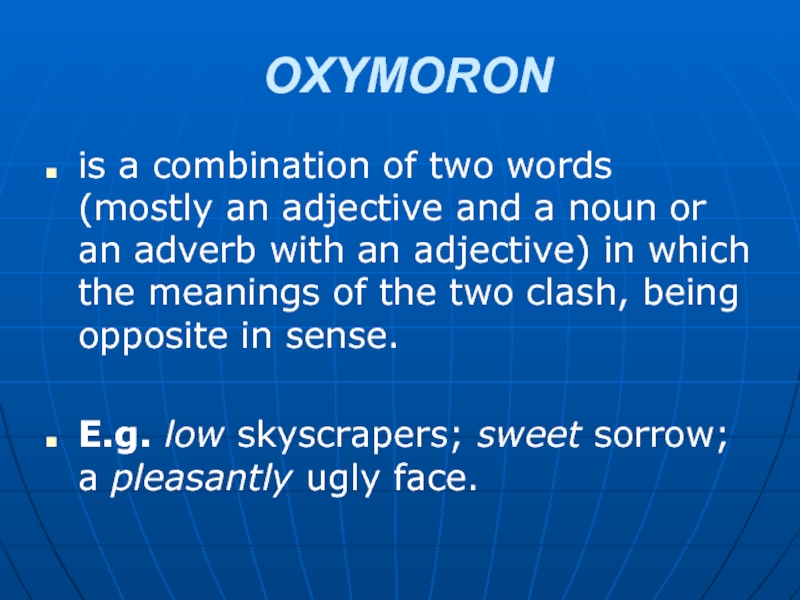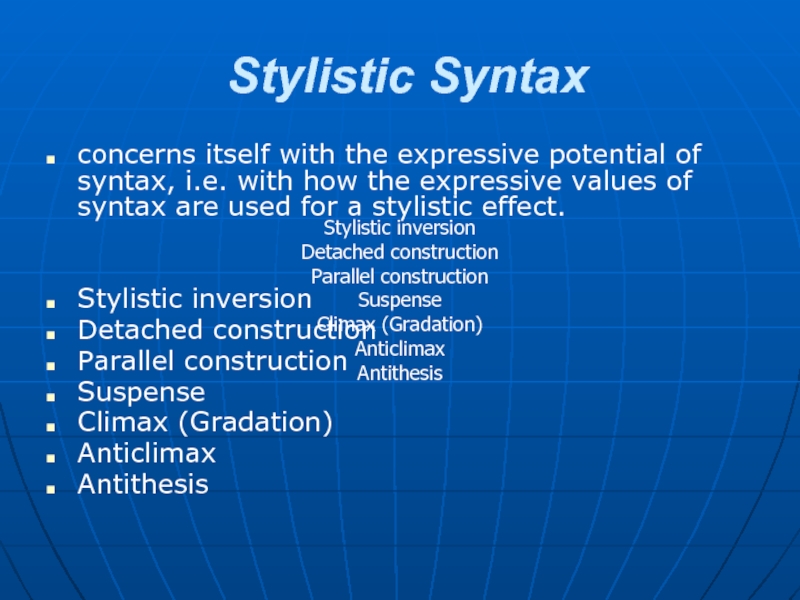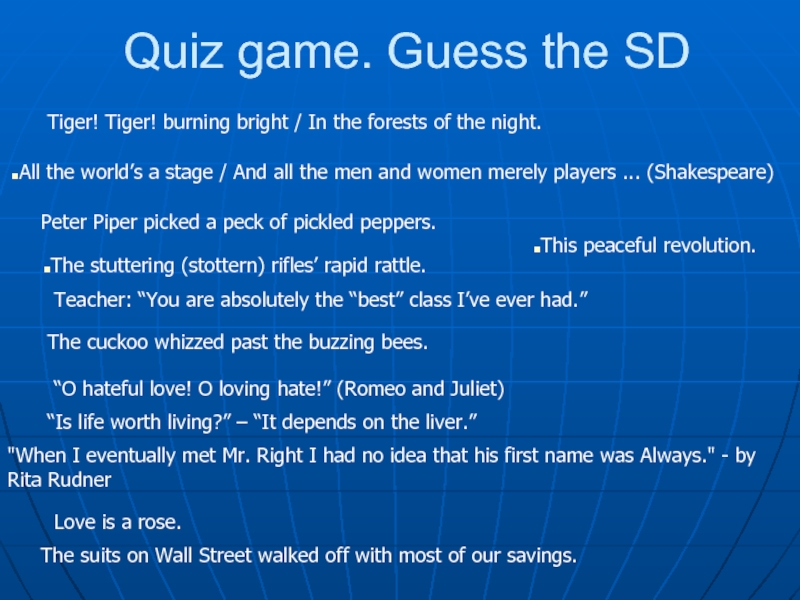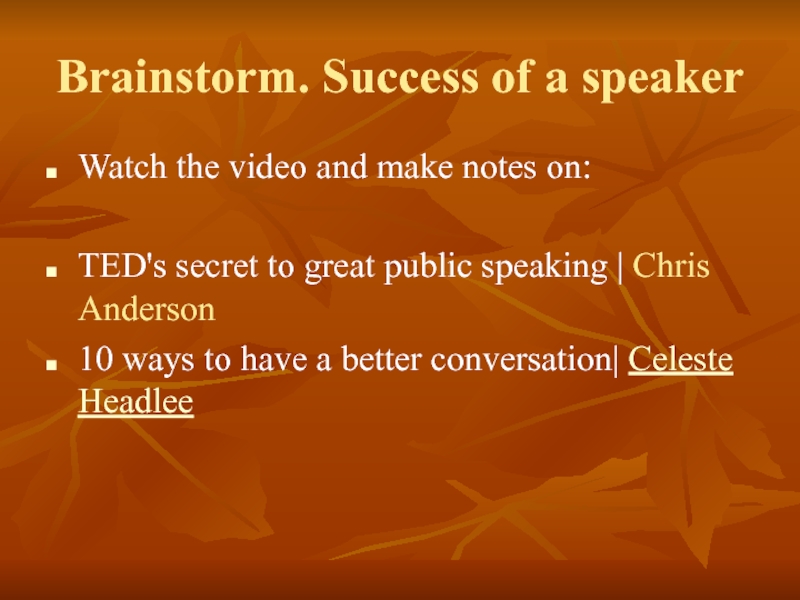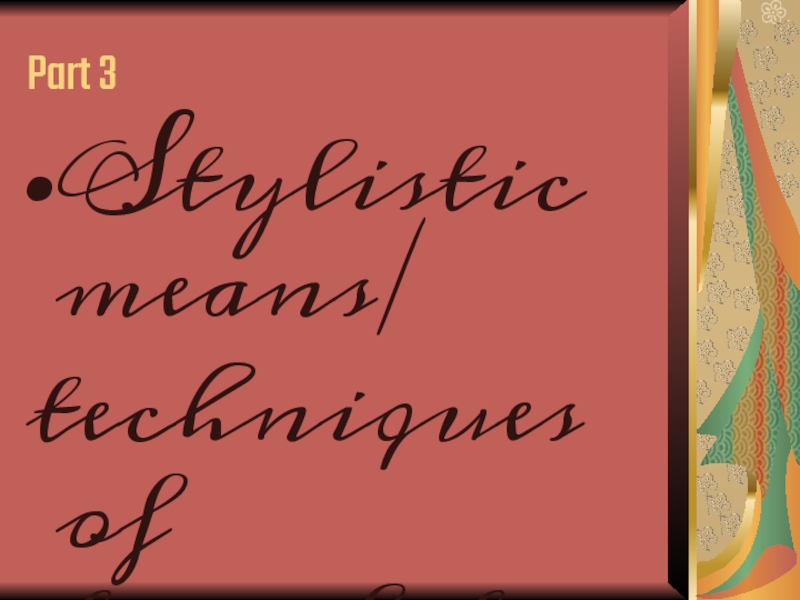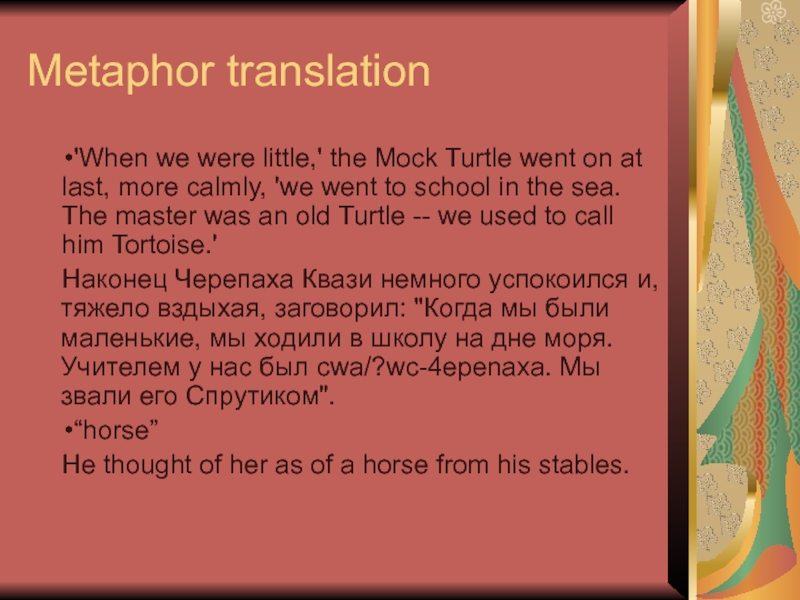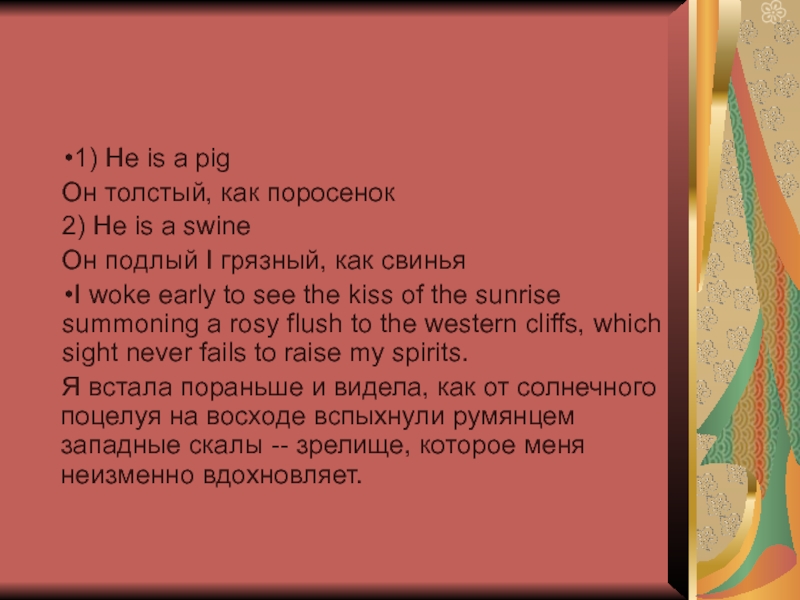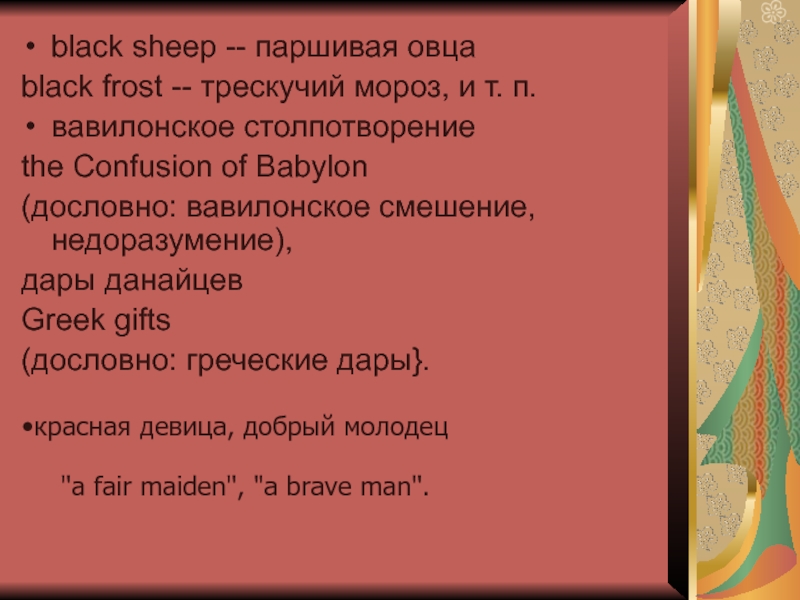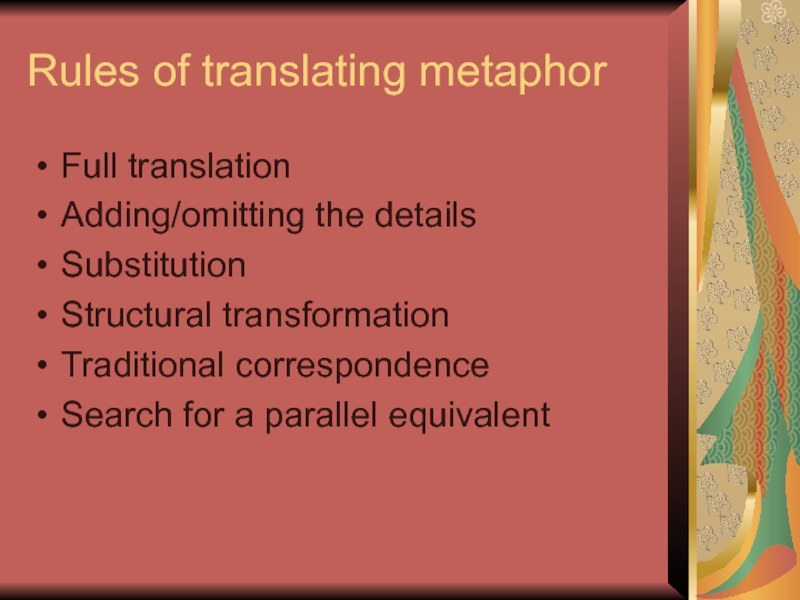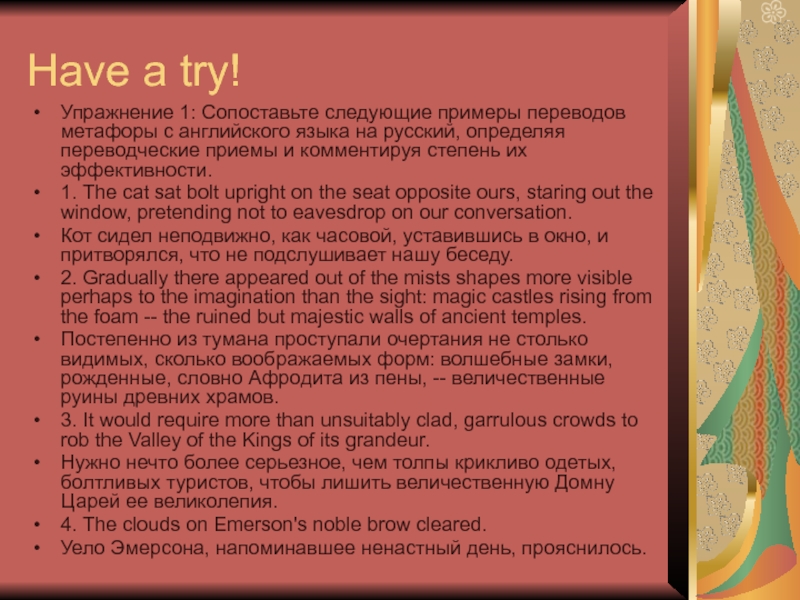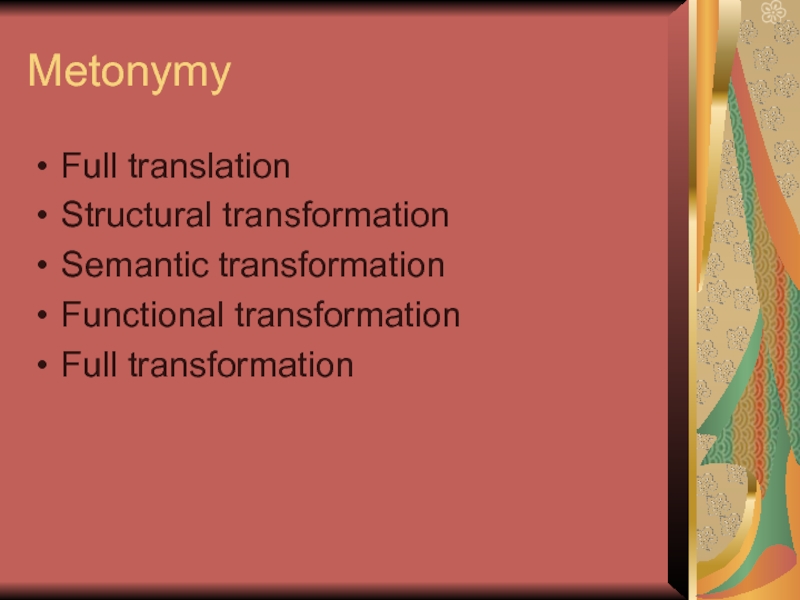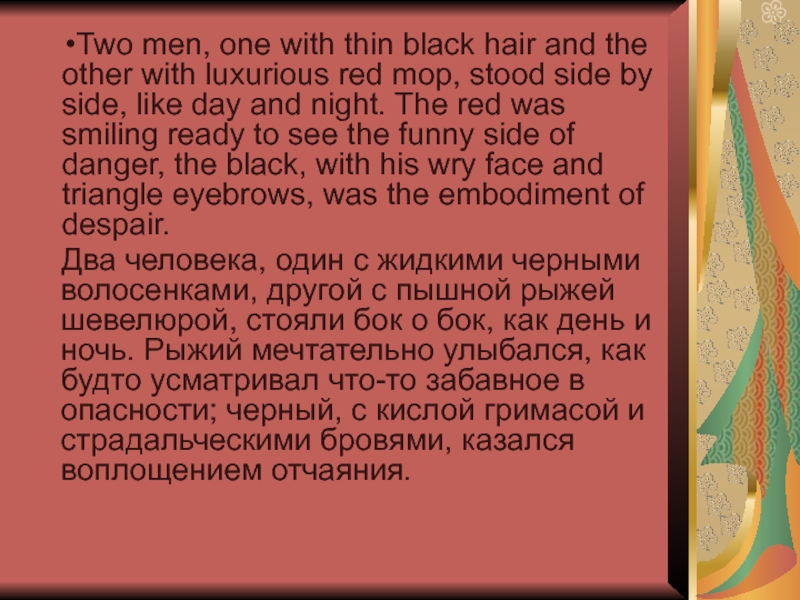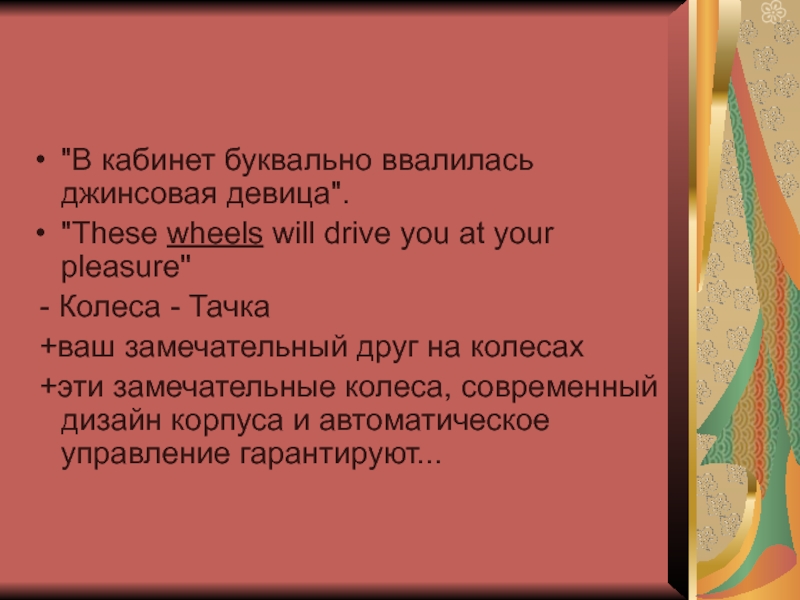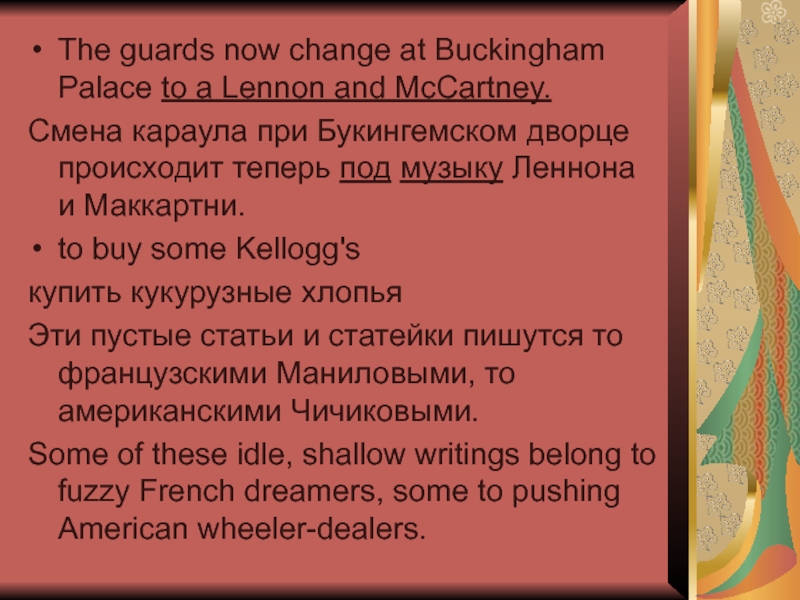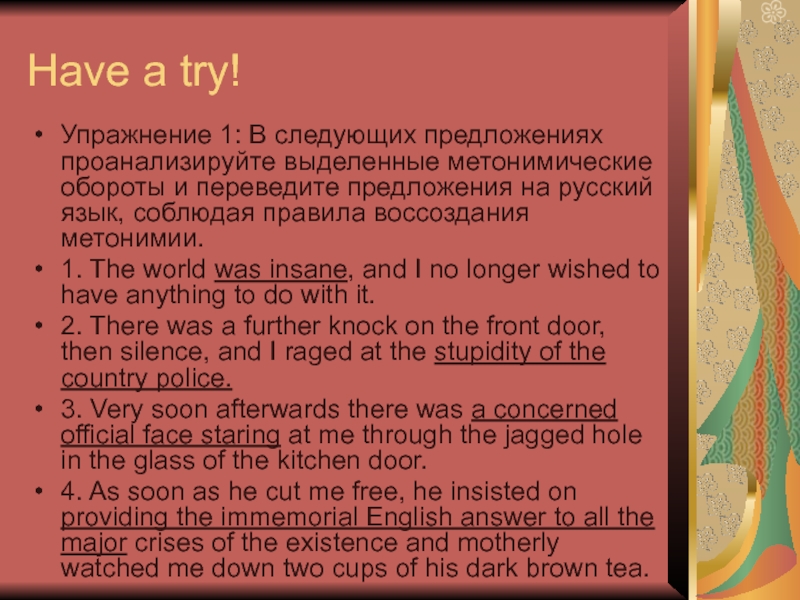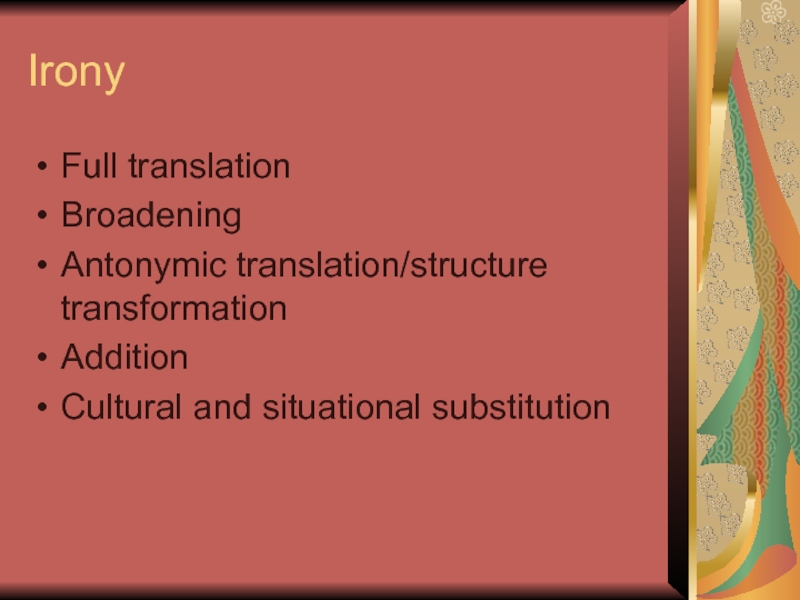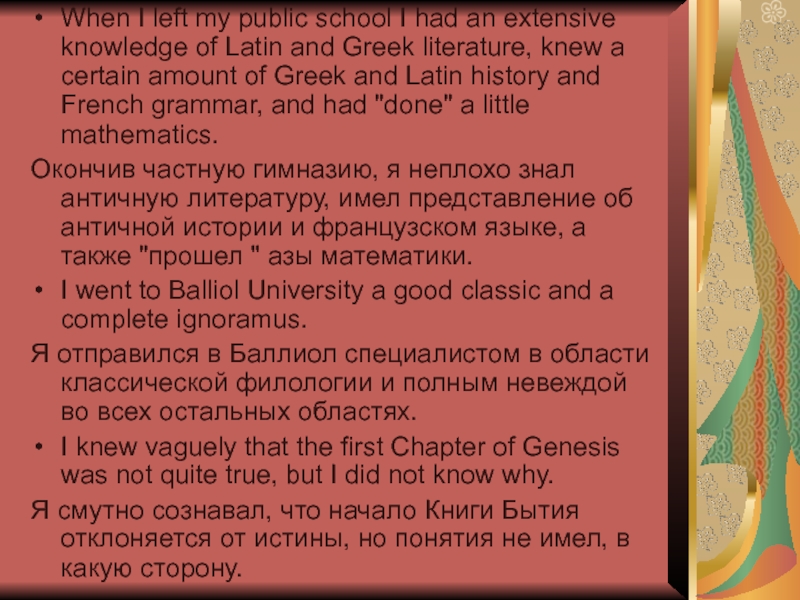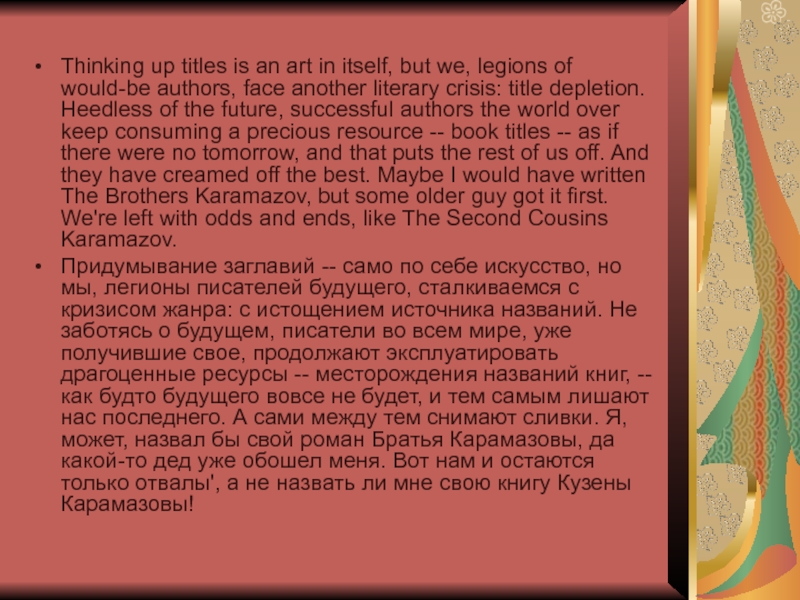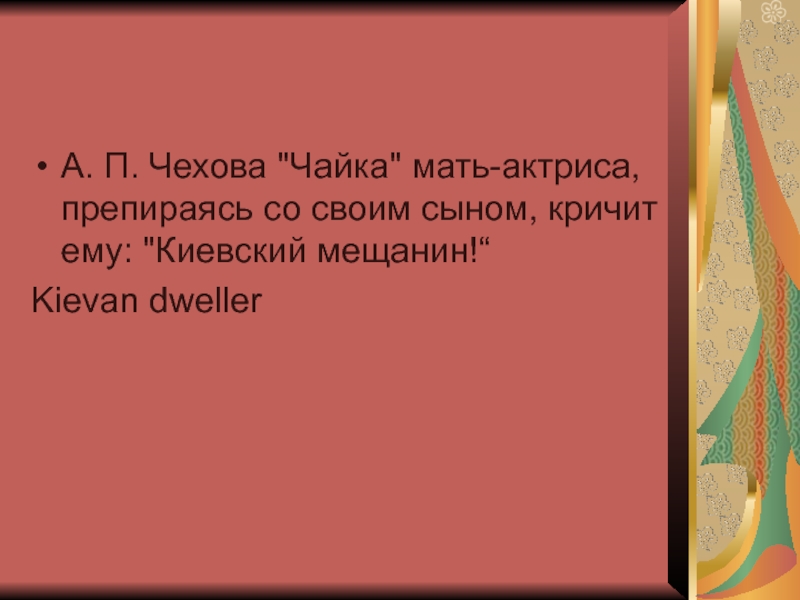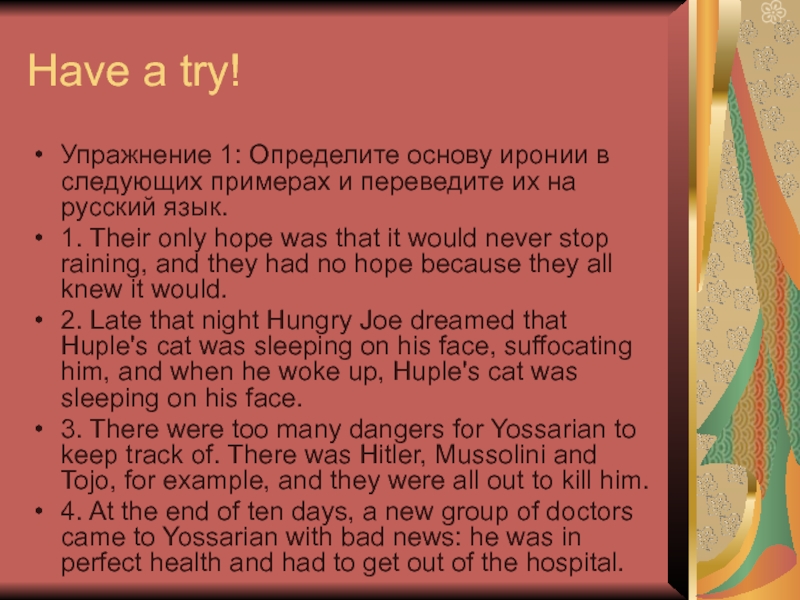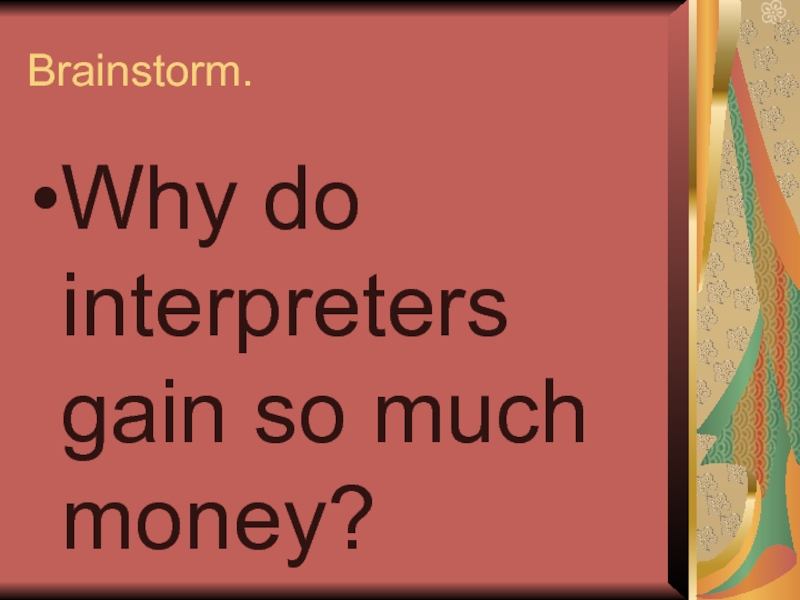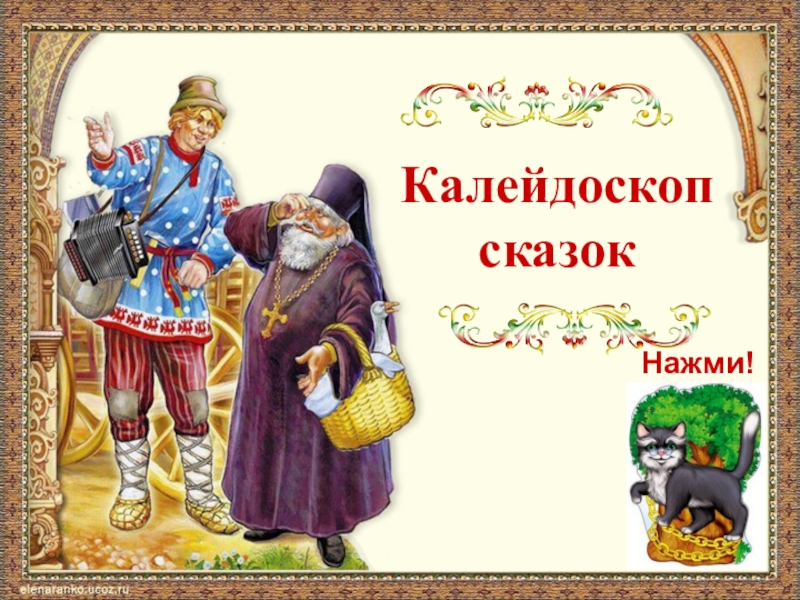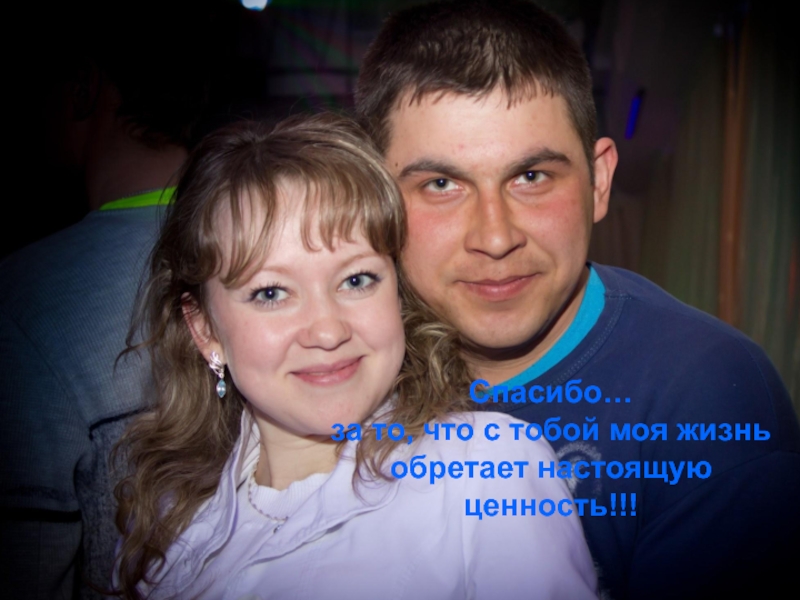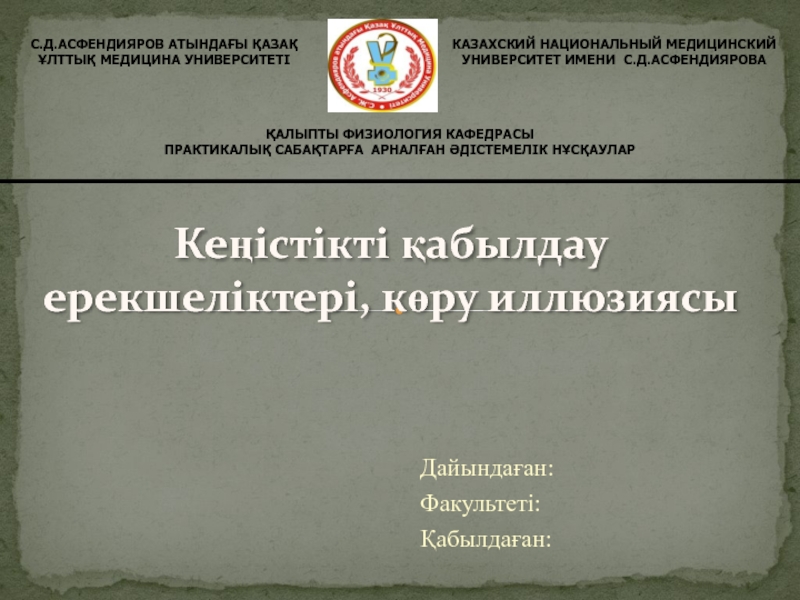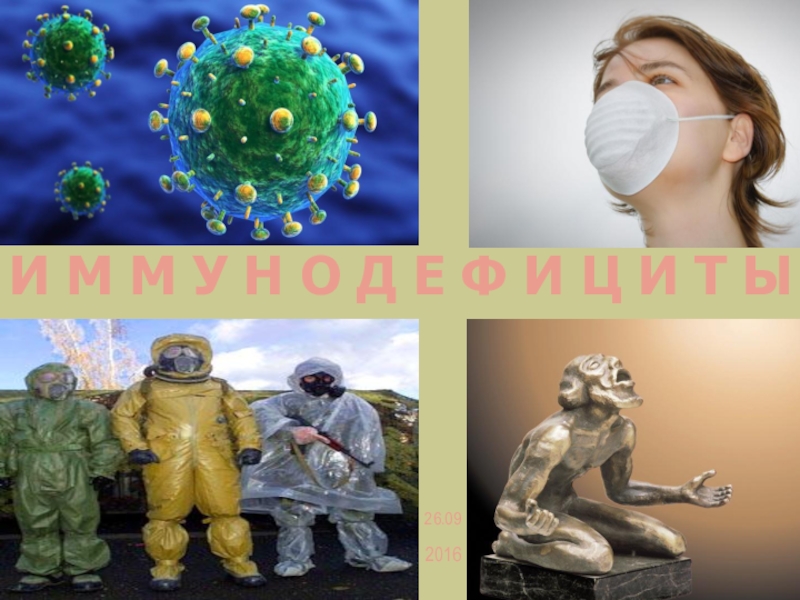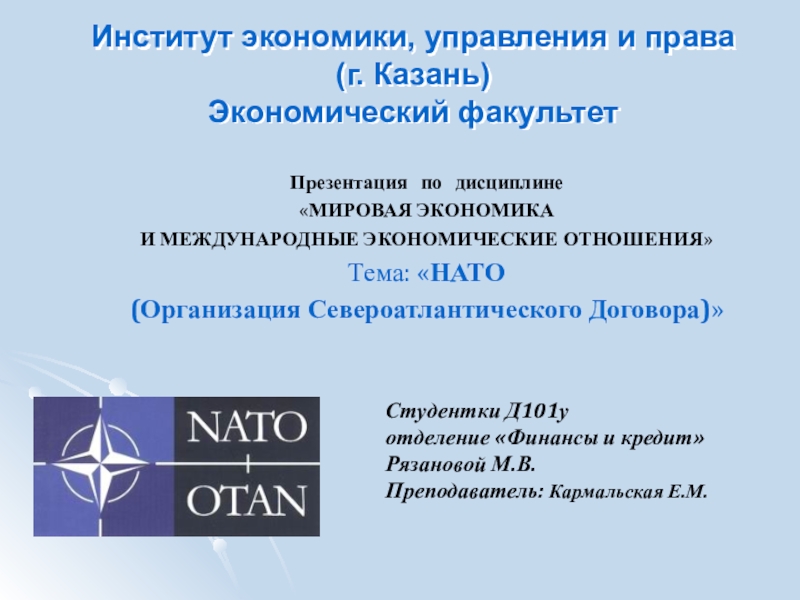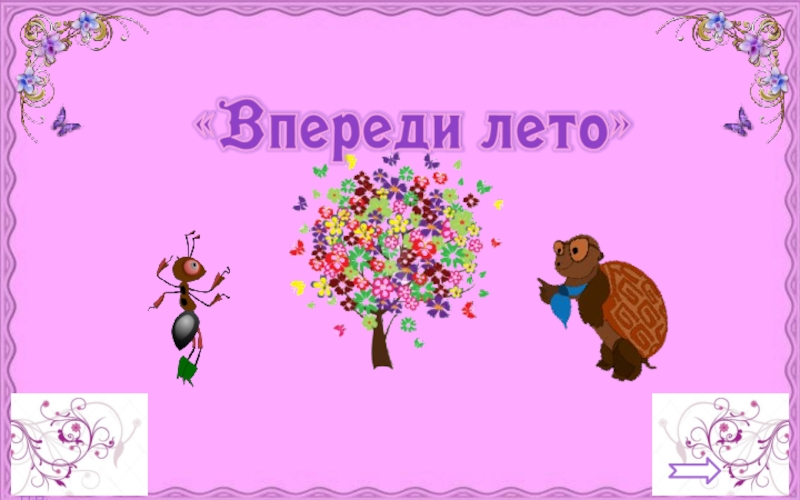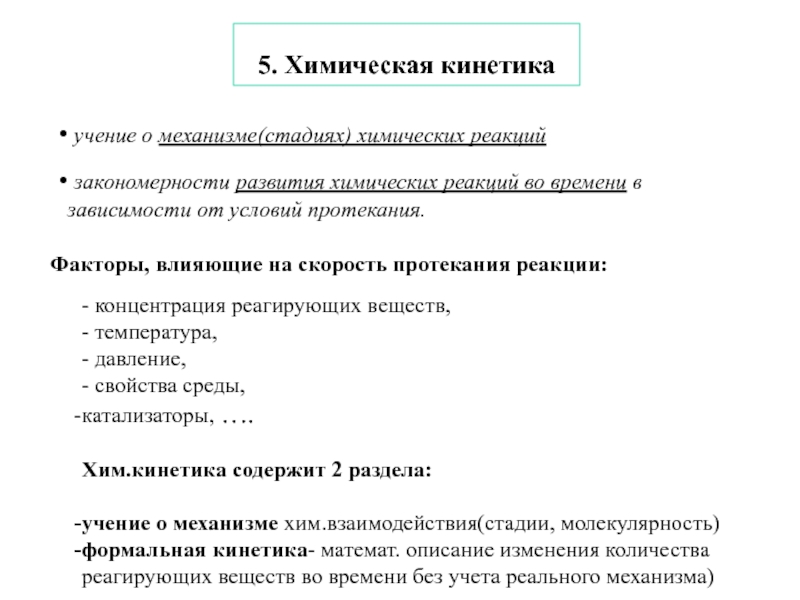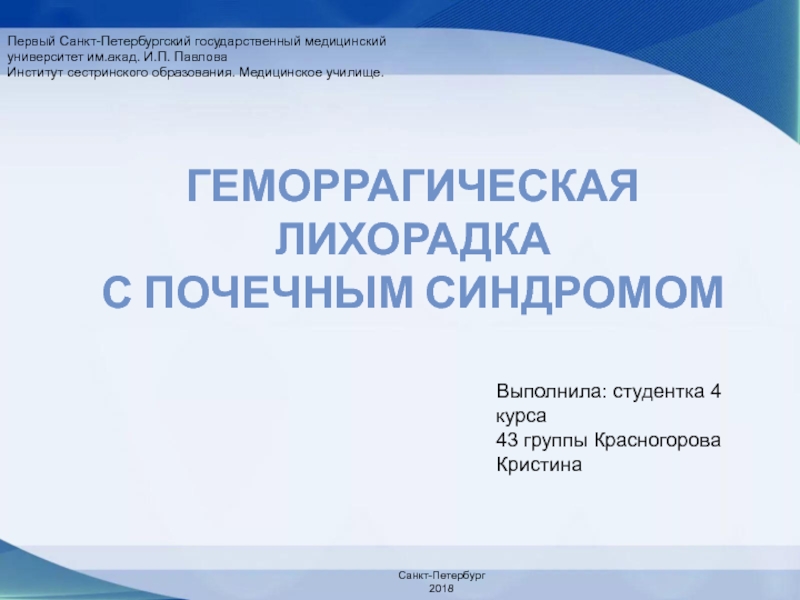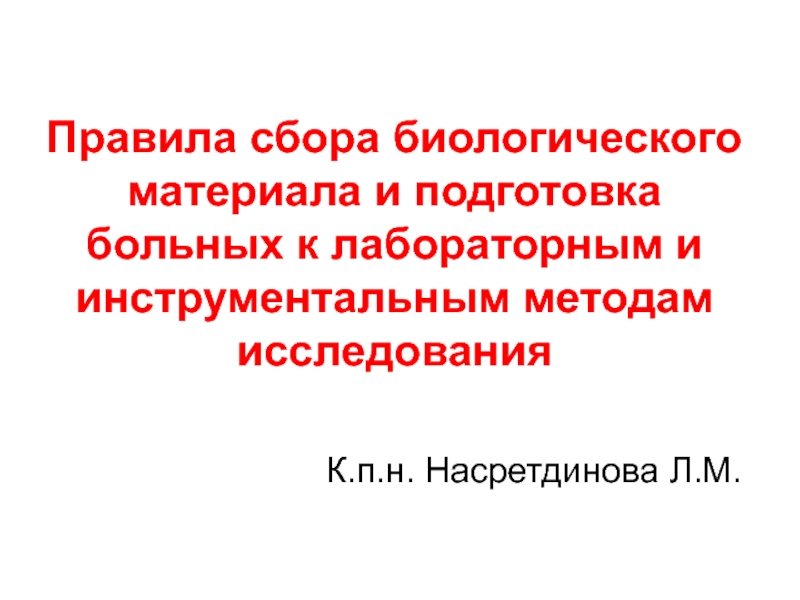Разделы презентаций
- Разное
- Английский язык
- Астрономия
- Алгебра
- Биология
- География
- Геометрия
- Детские презентации
- Информатика
- История
- Литература
- Математика
- Медицина
- Менеджмент
- Музыка
- МХК
- Немецкий язык
- ОБЖ
- Обществознание
- Окружающий мир
- Педагогика
- Русский язык
- Технология
- Физика
- Философия
- Химия
- Шаблоны, картинки для презентаций
- Экология
- Экономика
- Юриспруденция
Translation as a means of intercultural collaboration Перевод как средство
Содержание
- 1. Translation as a means of intercultural collaboration Перевод как средство
- 2. I saw Susie sitting in a shoe
- 3. While we were walking, we were watching
- 4. STYLISTIC MEANS/TECHNIQUES OF TRANSLATIONPart 1RevisionCheck and discuss
- 5. Part 1RevisionHome workPart 1
- 6. 1. Переведите текст на русский язык, сохраняя
- 7. 2. Сравните русский перевод с английским оригиналом
- 8. 3. В следующем тексте проанализируйте выделенные словосочетания,
- 9. Sentence level4. Переведите следующие предложения, обращая внимание
- 10. Brainstorm: Interpreter's etiquette 1. Translate the speech
- 11. Part 2Stylistic devicesAndExpressive means
- 12. Transference the act of name exchange, of
- 13. Expressive Means and Stylistic DevicesExpressive Means –
- 14. What is a stylistic device?
- 15. Expressive Means and Stylistic DevicesExample: “The night
- 16. Phonetic Expressive Means and SDOnomatopoeia – the
- 17. Слайд 17
- 18. Phonetic Expressive Means and SDAlliteration – the
- 19. Graphical Expressive Means and SDSound is foregrounded
- 20. Graphical Expressive Means and SDThe main functions
- 21. Various types of printTypes of print: Bold
- 22. Lexical expressive means and stylistic devicesMetaphor is a
- 23. METONYMYMetonymy is a figure of speech that refers
- 24. ANTONOMASIA is when a title is used in
- 25. SYNECDOCHEwhen a part is used instead of
- 26. IRONYis a SD based on the simultaneous
- 27. ZEUGMAis the use of a word in
- 28. PUNis another SD based on the interaction
- 29. EPITHETis a SD based on the interplay
- 30. OXYMORONis a combination of two words (mostly
- 31. Stylistic Syntaxconcerns itself with the expressive potential
- 32. Quiz game. Guess the SDTiger! Tiger! burning
- 33. Brainstorm. Success of a speakerWatch the video
- 34. Part 3Stylistic means/techniques of translation
- 35. Metaphor translation'When we were little,' the Mock
- 36. 1) Не is a pig Он толстый,
- 37. black sheep -- паршивая овца black frost
- 38. Rules of translating metaphorFull translationAdding/omitting the detailsSubstitutionStructural transformationTraditional correspondenceSearch for a parallel equivalent
- 39. Have a try!Упражнение 1: Сопоставьте следующие примеры
- 40. MetonymyFull translationStructural transformationSemantic transformationFunctional transformationFull transformation
- 41. Two men, one with thin black hair
- 42. "В кабинет буквально ввалилась джинсовая девица". "These
- 43. The guards now change at Buckingham Palace
- 44. Have a try!Упражнение 1: В следующих предложениях
- 45. IronyFull translationBroadeningAntonymic translation/structure transformationAdditionCultural and situational substitution
- 46. When I left my public school I
- 47. Thinking up titles is an art in
- 48. А. П. Чехова "Чайка" мать-актриса, препираясь со своим сыном, кричит ему: "Киевский мещанин!“Kievan dweller
- 49. Have a try!Упражнение 1: Определите основу иронии
- 50. Brainstorm.Why do interpreters gain so much money?
- 51. Скачать презентанцию
Слайды и текст этой презентации
Слайд 1Translation as a means of intercultural collaboration Перевод как средство межкультурного
взаимодействия
Слайд 2I saw Susie sitting in a shoe shine shop. Where she
sits she shines, and where she shines she sits.
She
sells sea shells on the sea shore;
The shells that she sells are sea shells I'm sure.
So if she sells sea shells on the sea shore,
I'm sure that the shells are sea shore shells. Слайд 3While we were walking, we were watching window washers wash
Washington's windows with warm washing water.
She stood on the balcony,
inexplicably mimicking him hiccuping, and amicably welcoming him in.an actor's vocal warmup for lips and tongue
Six thick thistle sticks
Слайд 4STYLISTIC MEANS/TECHNIQUES
OF TRANSLATION
Part 1
Revision
Check and discuss homework texts
Brainstorm:
A few
words about the etiquette of a translator/interpreter
Part 2
Expressive means and
stylistic devicesBrainstorm:
What does the success of a speaker start with?
A few tips on speech culture.
Part 3
Stylistic means/techniques of translation
Metaphors
Metonymy
Irony
Brainstorm
Why do the international interpreters/translators get so much money?
Слайд 61. Переведите текст на русский язык, сохраняя стилистические функции выделенных
грамматических форм. (Морфологические средства перевода в условиях совпадение грамматических форм)
No
country's history has been more closely bound to immigration than that of the United States. The Founding Fathers, especially Thomas Jefferson, were ambivalent over whether or not the United States ought to welcome arrivals from every comer of the globe. The author of America's Declaration of Independence wondered whether democracy could ever rest safely in the hands of men from countries that revered monarchs or replaced royalty with mob rule. However, few supported closing the gates to newcomers in a country desperate for labour. By the mid-1840s millions of immigrants made their way to America as a result of a potato blight in Ireland and continual revolution in the German homelands. Meanwhile, a trickle of Chinese immigrants began to approach the American West Coast. Almost 19 million people arrived in the United States between 1880 and 1921, the year Congress first passed severe restrictions. Most of these immigrants were from Italy, Russia, Poland, Greece and the Balkans. Non-Europeans came, too: east from Japan, south from Canada and north from Mexico.
Слайд 72. Сравните русский перевод с английским оригиналом с точки зрения
морфологических преобразований. Предложите свой вариант перевода с обоснованием приемов.
I
was early when I got there, so I just sat down on one of those leather couches right near the clock in the lobby and watched the girls. A lot of schools were home for vacation already, and there were about a million girls sitting and standing around waiting for their dates to show up. Girls with their legs crossed, girls with their legs not crossed, girls with terrific legs, girls with lousy legs, girls that looked like swell girls, girls that looked like they'd be bitches if you knew them. It was really nice sightseeing, if you know what I mean. In a way, it was sort of depressing, too, because you kept wondering what the hell would happen to all of them. When they got out of school and college, I mean. You figured most of them would probably marry dopey guys. Я приехал слишком рано, сел на кожаный диван под часами и стал разглядывать девчонок. Во многих пансионах и колледжах уже начались каникулы, и в холле толпились тысячи девчонок, ждали, пока за ними зайдут их кавалеры. Одни девчонки сидели, скрестив ноги, другие держались прямо, у одних девчонок ноги были мировые, у других -- безобразные, одни девчонки с виду были приличные, а по другим сразу было видно, что они дрянь, стоит их только поближе узнать. Вообще смотреть на них было приятно, вы меня понимаете. Приятно и вместе с тем как-то грустно, потому что все время думалось: а что с ними со всеми будет? Ну, окончат они свои колледжи, пансионы. Я подумал, что большинство, наверно, выйдут замуж за каких-нибудь гнусных типов.
Слайд 83. В следующем тексте проанализируйте выделенные словосочетания, которые подлежат преобразованию,
определите прием перевода для них и переведите текст.
Airplane Etiquette
Airports can bring out the worst in people. With our skies and planes so crowded, it's no longer possible to say exactly when a flight will depart. Scheduling meetings to begin forty minutes after your expected arrival time is foolish, and leads to the phenomenon we call Executive Stampede: the rude behaviour of clock-watching executives who, garment bags held high, think nothing of mauling anyone who happens to be in their way in their maniacal determination to be the first passengers off the plane and at the head of the taxi line. So spare yourself, your colleagues, and your clients the need to revise meeting schedules in order to cope with travel delays, by planning to arrive the night before a meeting. This will allow you to rest after a trip, schedule a productive breakfast meeting, and then use the entire day for meaningful work.
Слайд 9Sentence level
4. Переведите следующие предложения, обращая внимание на необходимость преобразования
синтаксических структур с применением перестановки, стяжения или распространения.
1. It's
pretty tough to make people understand you when you're talking to them with- two crab apples in your cheeks. 2. Yossarian decided not to utter another word, thinking that it would be futile.
3. He knew he was right, because, as he explained to Clevinger, to the best of his knowledge he had never been wrong.
5. Проанализируйте следующие предложения с точки зрения применимости антонимического перевода и переведите их. Возможны разные варианты.
1. The warrant officer was unimpressed by the entire incident and seldom spoke at all unless it was to show irritation.
2. It seemed there was a very little basis to their conversation at all.
3. It was impossible to go to the movie with him without getting involved afterward in a discussion.
Слайд 10Brainstorm:
Interpreter's etiquette
1. Translate the speech of only your side
2.
If you are working at a meeting with standing reception
be sure not to be disturbed by waiters – have your glass full. It is better not to eat or drink too much when working.3. Don’t eat or take anything that can prevent you from proper functioning.
4. When working at official meetings there will be special time for eating for everyone. Be sure you know the basis of table etiquette.
5. Be aware of cultural rules of behavior and traditions not to offence any native.
6. Mind the way you are dressed. It should be official: a suit, a tie.
7. Be attentive, listen and translate properly.
Слайд 12Transference
the act of name exchange, of substitution
The name of one
object is transferred onto another on the basis of:
a. their
similarity (of shape, color, function, form, etc.);b. Their closeness (of material existence, cause and effect, instrument and the result, part and whole relations, etc.).
Слайд 13Expressive Means and Stylistic Devices
Expressive Means – phonetic, morphological, word-building,
lexical, phraseological and syntactical forms which exist in language-as-a-system for
the purpose of logical and/or emotional intensification of the utterance. All these forms have neutral synonyms.Phonetic expressive means: pitch, melody, stress, whispering, manner of speaking, pauses, etc.
Слайд 14
What is a stylistic device?
A SD -
is a conscious and intentional literary use of some facts
of the language (including expressive means) with the purpose of further intensification of the emotional or logical emphasis contained in the corresponding expressive means.Слайд 15Expressive Means and Stylistic Devices
Example: “The night has swallowed him
up”
I. R. Galperin’s classification based on the level-oriented approach:
Phonetic expressive
means and stylistic devices.Graphical expressive means and stylistic devices.
Lexical expressive means and stylistic devices.
Syntactical expressive means and stylistic devices.
Слайд 16Phonetic Expressive Means and SD
Onomatopoeia – the use of words
whose sounds imitate those of an object or action: hiss,
murmur.A message with an onomatopoeic word carries not only the logical information, but also supplies the vivid portrayal of the situation described.
There are two varieties of onomatopoeia:
Direct onomatopoeia – words that imitate natural sounds, e.g. ding-dong, burr, bang, cuckoo.
Indirect onomatopoeia – a combination of sounds the aim of which is to make the sound of the utterance an echo of its sense.
And the silken, sad, uncertain rustling of each purple curtain.
Слайд 18Phonetic Expressive Means and SD
Alliteration – the repetition of consonants,
usually in the beginning of words, e.g., Muck and money
go together; Safe and sound.Assonance – the repetition of similar vowels, usually in stressed syllables. e.g. Dreadful young creatures – squealing and squawking.
Rhyme is the repetition of identical or similar terminal sound combination of words. Rhyming words are generally placed at a regular distance from each other. In verse they are usually placed at the end of the corresponding lines.
Rhythm is the pattern of interchange of strong and weak segments. It's a regular recurrence of stressed and unstressed syllables that make a poetic text.
Слайд 19Graphical Expressive Means and SD
Sound is foregrounded mainly through the
change of its accepted graphical representation. This intentional violation of
the graphical shape of a word used to reflect its authentic pronunciation is called graphon.Graphon – effective means of supplying information about the speaker's origin, social and educational background, physical or emotional condition, etc.
Слайд 20Graphical Expressive Means and SD
The main functions of graphon are:
to
express the author's attitude to the characters, e.g. butler Yellowplush
impresses his listeners with the learned words pronouncing them as "sellybrated" (celebrated), "bennyviolent" (benevolent).to show the physical defects of the speakers, e.g. the stuttering "The b-b-b-b-bas-tud - he seen me c--c-c-c-coming“,
to convey the atmosphere of authentic live communication, of the informality of the speech act, e.g. "gimme" (give me), "lemme" (let me), "gonna" (going to), "gotta" (got to), etc.
Слайд 21Various types of print
Types of print:
Bold type
Italics
CAPITALIZATION
/ Capitalization
Hy-phe-na-tion
S p a c e d l
e t t e r s M-m-multiplication
They are used to indicate the additional stress of the emphasized word or part of the word.
Слайд 22Lexical expressive means and stylistic devices
Metaphor is a trope, which means
transference of some quality from one object to another. It
is based on the simultaneous realization of primary dictionary and contextually imposed meanings. Metaphor is a method of description, which identifies one thing with another.There are three types of transference in Metaphor:
Transference of the name of one object to another
E.g. He was already familiar with the geography of the house.
Transference of the name of the action
E.g. He shot after her. /He suddenly started running very fast/
E.g. The time was bleeding for her. /went very slowly/
Transference of the typical features of one thing to another
E.g. The yellow pancake was high in the sky. /about the sun/
E.g. The old butterfly was sitting in her rocky-chair on the patio. /about an elderly lady/
Слайд 23METONYMY
Metonymy is a figure of speech that refers to something or
someone by naming one of its attributes.
We must wait to
hear from the crown until we make any further decisions.
three types of metonymy. All instances of metonymy involve using a word or phrase to replace another word or phrase with something similar.
Слайд 24ANTONOMASIA
is when a title is used in place of a
proper name OR when a proper name is used in
place of a title. Either way, by using an antonomasia, you are saying that that person or group you're talking about shares the same attribute as the proper name used or referred to.There is much of Cicero in this letter.
Слайд 25SYNECDOCHE
when a part is used instead of the whole OR
when the whole is used instead of the part.
At
the Olympics, you will hear that the United States won a gold medal in an event.
Слайд 26IRONY
is a SD based on the simultaneous realization of two
logical meanings – dictionary and contextual, which stand in opposition
to each other.E.g. It must be delightful to find oneself in a foreign country without a penny in one’s pocket.
Слайд 27ZEUGMA
is the use of a word in the same grammatical
but different semantic relations to two adjacent words in the
context. The two meanings of the word are realized in the context without the repetition of this word. It is often used in poetry and emotive prose.E.g. Mr. Stiggings took his hat and his leave.
A door on the second landing opened, and a face poked out wearing horn-rimmed glasses and a very annoyed expression
Слайд 28PUN
is another SD based on the interaction of two well-known
meanings ofаword or phrase. It aims at a humorous effect
and is used in jokes, riddles, etc.based on:
The play upon words with the same spelling and sounding, but different meaning
E.g.«Do you serve crabs here?»
«We serve anyone! Sit down!»
Слайд 29EPITHET
is a SD based on the interplay of logical and
emotive meanings in an attributive word, phrase or even sentence
used to characterize an object (both existing and imaginary).dark forest; careful attention; fantastic terrors
A heart-burning smile
Слайд 30OXYMORON
is a combination of two words (mostly an adjective and
a noun or an adverb with an adjective) in which
the meanings of the two clash, being opposite in sense.E.g. low skyscrapers; sweet sorrow; a pleasantly ugly face.
Слайд 31Stylistic Syntax
concerns itself with the expressive potential of syntax, i.e.
with how the expressive values of syntax are used for
a stylistic effect.Stylistic inversion
Detached construction
Parallel construction
Suspense
Climax (Gradation)
Anticlimax
Antithesis
Stylistic inversion
Detached construction
Parallel construction
Suspense
Climax (Gradation)
Anticlimax
Antithesis
Слайд 32Quiz game. Guess the SD
Tiger! Tiger! burning bright / In
the forests of the night.
All the world’s a stage /
And all the men and women merely players ... (Shakespeare) Peter Piper picked a peck of pickled peppers.
The stuttering (stottern) rifles’ rapid rattle.
Teacher: “You are absolutely the “best” class I’ve ever had.”
The cuckoo whizzed past the buzzing bees.
“O hateful love! O loving hate!” (Romeo and Juliet)
“Is life worth living?” – “It depends on the liver.”
"When I eventually met Mr. Right I had no idea that his first name was Always." - by Rita Rudner
Love is a rose.
The suits on Wall Street walked off with most of our savings.
This peaceful revolution.
Слайд 33Brainstorm. Success of a speaker
Watch the video and make notes
on:
TED's secret to great public speaking | Chris Anderson
10 ways
to have a better conversation| Celeste HeadleeСлайд 35Metaphor translation
'When we were little,' the Mock Turtle went on
at last, more calmly, 'we went to school in the
sea. The master was an old Turtle -- we used to call him Tortoise.'Наконец Черепаха Квази немного успокоился и, тяжело вздыхая, заговорил: "Когда мы были маленькие, мы ходили в школу на дне моря. Учителем у нас был cwa/?wc-4epenaxa. Мы звали его Спрутиком".
“horse”
Не thought of her as of a horse from his stables.
Слайд 361) Не is a pig
Он толстый, как поросенок
2)
Не is a swine
Он подлый I грязный, как свинья
I
woke early to see the kiss of the sunrise summoning a rosy flush to the western cliffs, which sight never fails to raise my spirits. Я встала пораньше и видела, как от солнечного поцелуя на восходе вспыхнули румянцем западные скалы -- зрелище, которое меня неизменно вдохновляет.
Слайд 37black sheep -- паршивая овца
black frost -- трескучий мороз,
и т. п.
вавилонское столпотворение
the Confusion of Babylon
(дословно:
вавилонское смешение, недоразумение), дары данайцев
Greek gifts
(дословно: греческие дары}.
красная девица, добрый молодец
"a fair maiden", "a brave man".
Слайд 38Rules of translating metaphor
Full translation
Adding/omitting the details
Substitution
Structural transformation
Traditional correspondence
Search for
a parallel equivalent
Слайд 39Have a try!
Упражнение 1: Сопоставьте следующие примеры переводов метафоры с
английского языка на русский, определяя переводческие приемы и комментируя степень
их эффективности.1. The cat sat bolt upright on the seat opposite ours, staring out the window, pretending not to eavesdrop on our conversation.
Кот сидел неподвижно, как часовой, уставившись в окно, и притворялся, что не подслушивает нашу беседу.
2. Gradually there appeared out of the mists shapes more visible perhaps to the imagination than the sight: magic castles rising from the foam -- the ruined but majestic walls of ancient temples.
Постепенно из тумана проступали очертания не столько видимых, сколько воображаемых форм: волшебные замки, рожденные, словно Афродита из пены, -- величественные руины древних храмов.
3. It would require more than unsuitably clad, garrulous crowds to rob the Valley of the Kings of its grandeur.
Нужно нечто более серьезное, чем толпы крикливо одетых, болтливых туристов, чтобы лишить величественную Домну Царей ее великолепия.
4. The clouds on Emerson's noble brow cleared.
Уело Эмерсона, напоминавшее ненастный день, прояснилось.
Слайд 40Metonymy
Full translation
Structural transformation
Semantic transformation
Functional transformation
Full transformation
Слайд 41Two men, one with thin black hair and the other
with luxurious red mop, stood side by side, like day
and night. The red was smiling ready to see the funny side of danger, the black, with his wry face and triangle eyebrows, was the embodiment of despair.Два человека, один с жидкими черными волосенками, другой с пышной рыжей шевелюрой, стояли бок о бок, как день и ночь. Рыжий мечтательно улыбался, как будто усматривал что-то забавное в опасности; черный, с кислой гримасой и страдальческими бровями, казался воплощением отчаяния.
Слайд 42"В кабинет буквально ввалилась джинсовая девица".
"These wheels will drive
you at your pleasure"
- Колеса - Тачка
+ваш замечательный друг на колесах +эти замечательные колеса, современный дизайн корпуса и автоматическое управление гарантируют...
Слайд 43The guards now change at Buckingham Palace to a Lennon
and McCartney.
Смена караула при Букингемском дворце происходит теперь под музыку
Леннона и Маккартни.to buy some Kellogg's
купить кукурузные хлопья
Эти пустые статьи и статейки пишутся то французскими Маниловыми, то американскими Чичиковыми.
Some of these idle, shallow writings belong to fuzzy French dreamers, some to pushing American wheeler-dealers.
Слайд 44Have a try!
Упражнение 1: В следующих предложениях проанализируйте выделенные метонимические
обороты и переведите предложения на русский язык, соблюдая правила воссоздания
метонимии.1. The world was insane, and I no longer wished to have anything to do with it.
2. There was a further knock on the front door, then silence, and I raged at the stupidity of the country police.
3. Very soon afterwards there was a concerned official face staring at me through the jagged hole in the glass of the kitchen door.
4. As soon as he cut me free, he insisted on providing the immemorial English answer to all the major crises of the existence and motherly watched me down two cups of his dark brown tea.
Слайд 45Irony
Full translation
Broadening
Antonymic translation/structure transformation
Addition
Cultural and situational substitution
Слайд 46When I left my public school I had an extensive
knowledge of Latin and Greek literature, knew a certain amount
of Greek and Latin history and French grammar, and had "done" a little mathematics.Окончив частную гимназию, я неплохо знал античную литературу, имел представление об античной истории и французском языке, а также "прошел " азы математики.
I went to Balliol University a good classic and a complete ignoramus.
Я отправился в Баллиол специалистом в области классической филологии и полным невеждой во всех остальных областях.
I knew vaguely that the first Chapter of Genesis was not quite true, but I did not know why.
Я смутно сознавал, что начало Книги Бытия отклоняется от истины, но понятия не имел, в какую сторону.
Слайд 47Thinking up titles is an art in itself, but we,
legions of would-be authors, face another literary crisis: title depletion.
Heedless of the future, successful authors the world over keep consuming a precious resource -- book titles -- as if there were no tomorrow, and that puts the rest of us off. And they have creamed off the best. Maybe I would have written The Brothers Karamazov, but some older guy got it first. We're left with odds and ends, like The Second Cousins Karamazov.Придумывание заглавий -- само по себе искусство, но мы, легионы писателей будущего, сталкиваемся с кризисом жанра: с истощением источника названий. Не заботясь о будущем, писатели во всем мире, уже получившие свое, продолжают эксплуатировать драгоценные ресурсы -- месторождения названий книг, -- как будто будущего вовсе не будет, и тем самым лишают нас последнего. А сами между тем снимают сливки. Я, может, назвал бы свой роман Братья Карамазовы, да какой-то дед уже обошел меня. Вот нам и остаются только отвалы', а не назвать ли мне свою книгу Кузены Карамазовы!
Слайд 48А. П. Чехова "Чайка" мать-актриса, препираясь со своим сыном, кричит
ему: "Киевский мещанин!“
Kievan dweller
Слайд 49Have a try!
Упражнение 1: Определите основу иронии в следующих примерах
и переведите их на русский язык.
1. Their only hope
was that it would never stop raining, and they had no hope because they all knew it would. 2. Late that night Hungry Joe dreamed that Huple's cat was sleeping on his face, suffocating him, and when he woke up, Huple's cat was sleeping on his face.
3. There were too many dangers for Yossarian to keep track of. There was Hitler, Mussolini and Tojo, for example, and they were all out to kill him.
4. At the end of ten days, a new group of doctors came to Yossarian with bad news: he was in perfect health and had to get out of the hospital.
